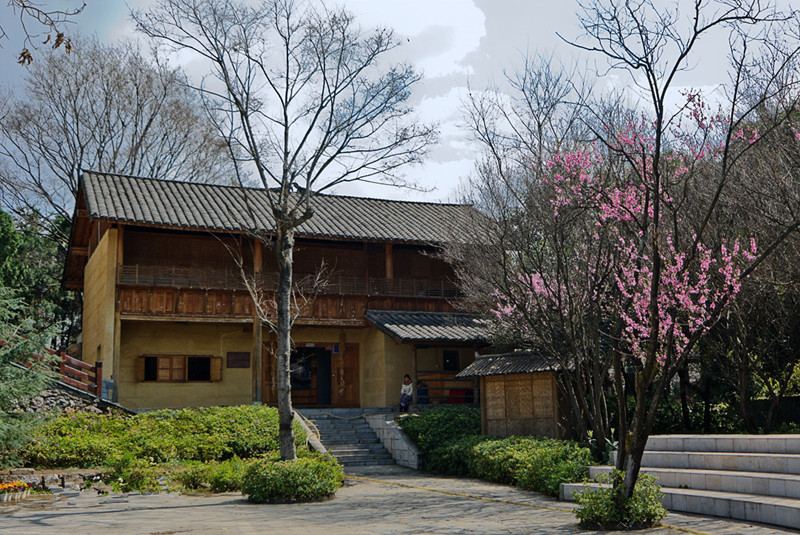Introduction to the Shui Ethnic Minority (水族)
The Shui ethnic minority (水族) in Yunnan (云南) comprises approximately 9,000 people, primarily engaged in agriculture. They reside mainly in the ancient Gugan Shui Ethnic Township (古干水族乡) and Huangnihe Town (黄泥河镇) of Fuyuan County (富源县). The origins of the Shui people can be traced back to the ancient “Baiyue” (百越), developing from a branch of the “Luoyue” (罗越) ethnic group. In ancient times, they referred to themselves as “Sui,” which was transliterated into “Shui” in Mandarin, thus giving them their name. The Shui people have their own language but predominantly use Chinese in daily life. They also had an ancient calendar based on lunar phases, and the “Shui Book” (水书) is renowned as a living encyclopedia of folklore due to its long history. The Shui people firmly believe in a primitive religion that emphasizes that “all things have spirits and souls endure,” which is reflected in their tradition of placing “Tunkou” (屯口) masks at the entrances of their homes to ward off evil spirits and pray for peace and auspiciousness.
Architecture of Shui Ethnic Villages
The Shui Village (水族村) in the Yunnan Ethnic Village is built along the water’s edge and integrates farming tools into its scenery. The architecture predominantly features the traditional “street house” style of the representative wooden houses from Gugan Shui Ethnic Township (古干水族乡) in Fuyuan County (富源县). The layout includes scenic spots like the Bagua Wheel (八卦轮), Longtan (龙潭), and Dalong Tree (大龙树), showcasing the ancestral culture and unique characteristics of the Shui people.
The Duan Festival (端午节)
The Duan Festival (端午节) is the most widespread, widely celebrated, and longest-lasting festival among the Shui people, regarded as their grandest annual celebration. In 2006, the “Shui Duan Festival” (水族端午节) and the “Shui Mao Festival” (水族毛节) were listed as national-level and provincial-level intangible cultural heritage, respectively.
Traditional Clothing of the Shui Ethnic Minority
The Shui people’s clothing is characterized by elegant colors and meticulous tailoring, showcasing a beautiful silhouette. Shui culture and attire share close ties with the Zhuang ethnic group (壮族) of Yunnan, yet differ significantly from the Shui people in Guizhou (贵州).
Shui clothing is simple and vibrant, with a particular fondness for blue, white, and indigo colors, exuding an elegant charm. Traditionally, they wore short tops paired with long skirts, while modern attire typically features short tops with pants. Their clothing is crafted from hemp fabric, presenting a simple beauty akin to a landscape painting.
Women’s Clothing
Shui women (水族女性) wear a right-opening blouse secured with a left knot, adorned with lace along the edges and embroidered corner borders. The trousers are fitted at the waist and hips, flared at the legs, resembling bell-bottoms that accentuate the natural curves of Shui women.
Men’s Clothing
Shui men (水族男性) wear large-collared, collarless blue shirts, designed for ease of labor.
Traditional Shui Street Houses
The Shui Village (水族村) in Yunnan Ethnic Village (云南民族村) is constructed along the water’s edge, featuring farm tools arranged in artistic formations. It primarily showcases the traditional wooden houses from Gugan Shui Ethnic Township (古干水族乡). The village is surrounded by scenic spots like the Bagua Wheel (八卦轮), Longtan (龙潭), and Dalong Tree (大龙树), reflecting the ancestral customs and unique characteristics of Shui culture.
Typically, the main entrance of a Shui household features a wooden sculpture of a fierce-looking Tunkou mask (屯口面具), which symbolizes protection and the wish for family safety and happiness.
Shui street houses (水族街屋) are rich in ancient charm, usually comprising a main house and two side rooms in a courtyard layout. The layout separates living spaces for people and animals, ensuring full functionality. The main house features a gable roof, constructed from wood and stone, with one floor and a basement. The basement usually consists of three rooms: a central hall and living spaces with a kitchen on either side, allowing for independent yet interconnected living. The upper level is often used for grain storage.
Tongkou Dance: A Unique Traditional Dance (铜口舞)
The Tongkou Dance (铜口舞) is unique to the Gugan Shui people, referred to as “Langji Gen” (狼骑根) in their language, symbolizing divine protection. It is one of the traditional dance forms exclusive to the Shui people of Yunnan.
The dance uses the Shui people’s auspicious symbol—the Tunkou mask (屯口面具)—as a prop. The Tunkou mask, which features a human head with a fierce expression and a sword in its mouth, symbolizes the ability to drive away evil spirits.
The “Tongkou Dance” (铜口舞) features passionate and robust movements, with performers wielding the Tunkou mask to sweep the surroundings, drawing swords toward the heavens, showcasing a sense of divine power and martial beauty.
Culinary Delights: Niu Da Gun (牛打滚)
The Shui people have a long history of rice cultivation and primarily consume rice, with a particular fondness for glutinous rice. “Niu Da Gun” (牛打滚) is a traditional and representative glutinous rice snack of the Shui people.
The preparation and ingredients for “Niu Da Gun” (牛打滚) are simple, yet the taste is unique. The glutinous rice balls are rolled in bean flour, coating them entirely. The result is a chewy and fragrant delicacy. This method resembles water buffalo rolling in mud, leading the Shui people to call it “Niu Da Gun” (牛打滚).
If you visit the Yunnan Ethnic Village (云南民族村) and pass by the Shui Village (水族村), be sure to sample the soft and sweet Shui snack “Niu Da Gun” (牛打滚) to make your journey truly delightful!
The Shui Book: A Cultural Heritage (水书)
The Shui Book (水书) has a long history and is known as “Le Sui” (乐水) in the Shui language, passed down through generations by Shui scholars and derived from Chinese characters. Its shapes resemble oracle bone script (甲骨文) and bronze inscriptions (青铜铭文), primarily used to record the Shui people’s astronomical, geographical, religious, folklore, ethical, and philosophical cultural information. It is one of the few surviving pictographs in the world, alongside the Dongba script (东巴文), and was listed as a national-level intangible cultural heritage in 2006.
The Shui Book (水书) is an ancient ethnic document, and copies can still be found in the regions inhabited by the Shui (水族) and Bouyei (布依族) people. The Eight Trigrams of Fuxi (伏羲八卦), also known as the Pre-Heaven Eight Trigrams, is one of the valuable pieces of information preserved in the Shui Book (水书).
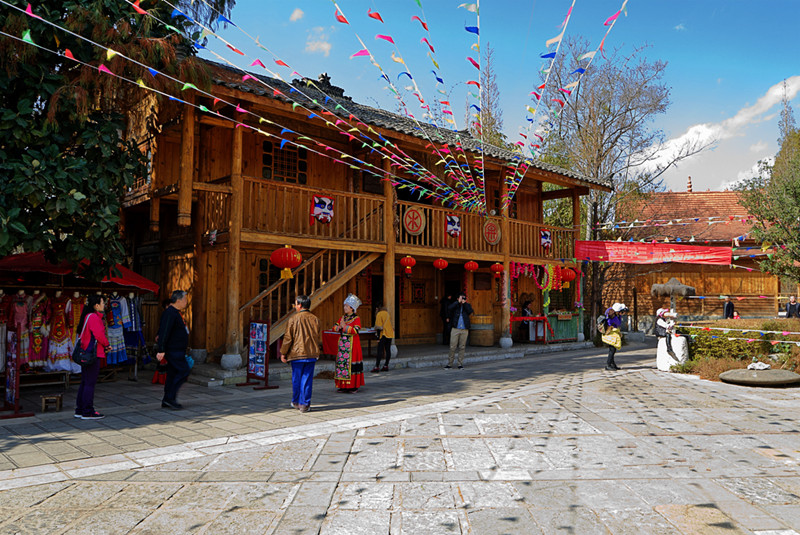
Overview of the Zhuang Ethnic Minority
The Zhuang (壮族) people predominantly reside in Wenshan Zhuang and Miao Autonomous Prefecture (文山州), with a population of approximately 1.22 million. Their villages are mostly located near mountains and water. The Zhuang are skilled rice cultivators and practice customs such as sun worship and ancestor veneration. They regard the bronze drum as a significant cultural artifact, favor silver jewelry, and are known for their culinary skills in preparing five-color rice (五色花米饭). The Zhuang people are also known for their singing, dancing, and hospitality.
Architectural Features of the Zhuang Village
Upon entering the Zhuang Village (壮族村) in Yunnan Ethnic Village (云南民族村), visitors are greeted by the Dragon Pillar (龙柱) dedicated to the worship of the Dragon King. On either side, there are paintings on the cliffs known as Heavenly King’s Cliff Paintings (天王崖画) created by their ancestors, and a Stone Gourd Pavilion (石葫芦亭) built to commemorate the legends of ancestral assistance during a great flood.
Flanking the square are the Haotian Pavilion (昊天阁), dedicated to the Jade Emperor (玉皇大帝), and a large bronze drum (硕大铜鼓) believed to ward off evil and attract good fortune. The village features various architectural styles, including:
- Rafted-style houses (杆栏式民居)
- Hemp-fenced houses (麻栏式民居)
- “Love Corridor” (情廊) for Zhuang youth to socialize and relax
- Elder’s Pavilion (老人亭) for village elders to hold discussions
Additionally, the village includes Dragon Trees (龙树) and “Sanqi” Gardens (三七园). A little further away, visitors can find a uniquely designed Wind and Rain Bridge (风雨桥) and a rotating waterwheel (水车), which together create a picturesque pastoral scene of Zhuang countryside.
Cultural Festivals and Arts
The Zhuang people hold several traditional folk song gatherings throughout the year, with the “March 3” Song Festival (三月三) being the most grandiose, celebrated on the third day of the third lunar month each year.
Zhuang brocade (壮锦) is a unique weaving art passed down through generations within the Zhuang community. It is recognized as one of China’s Four Famous Brocades, alongside Nanjing Yunjin (南京的云锦), Chengdu Shujin (成都的蜀锦), and Suzhou Songjin (苏州的宋锦).
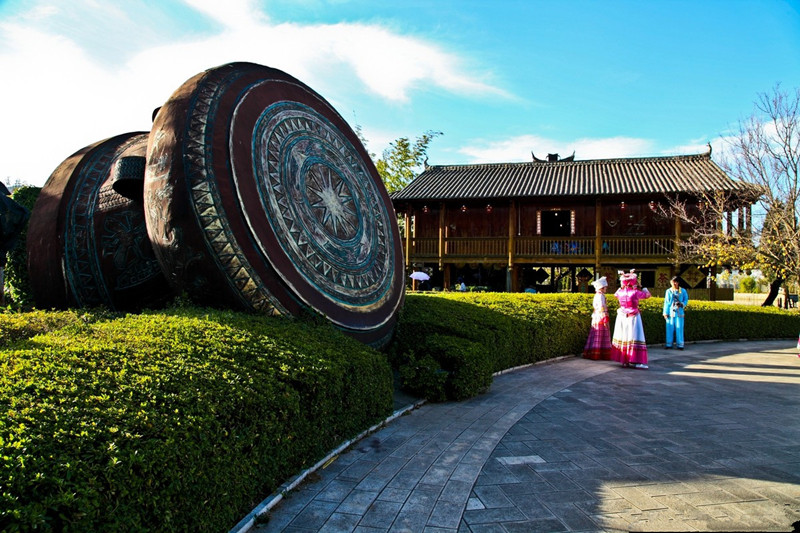
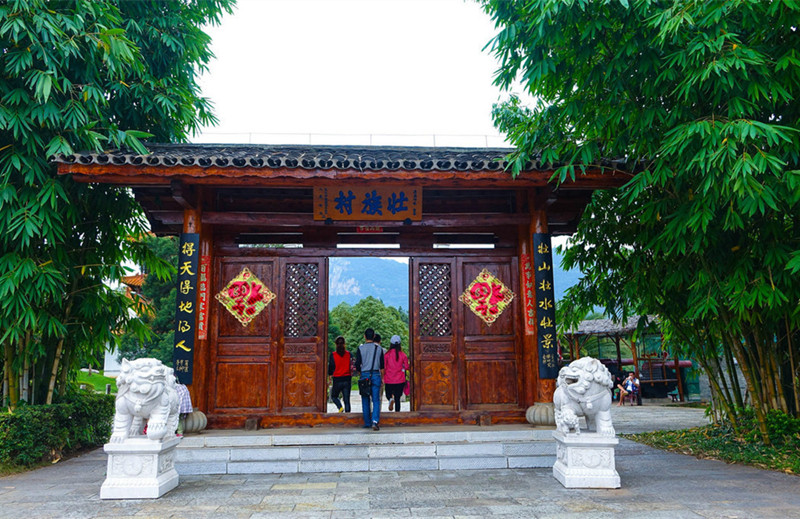
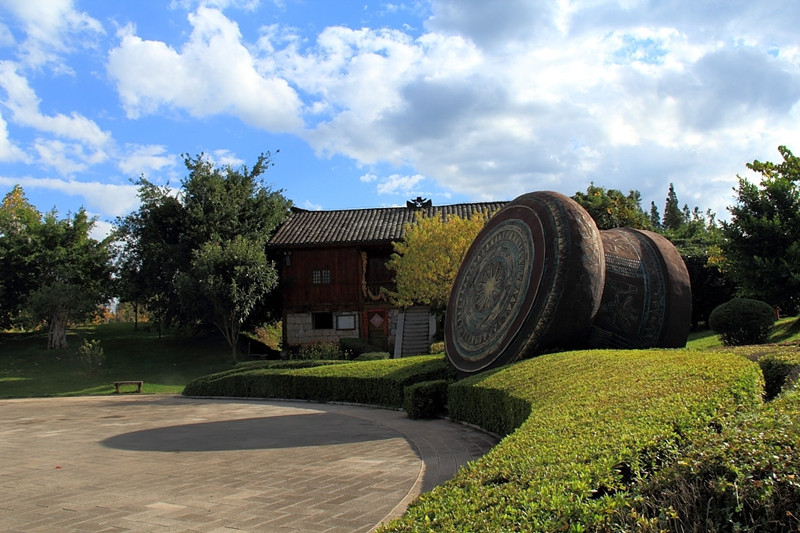
Overview of the Miao Ethnic Minority
The Miao (苗族) people primarily engage in mountainous agriculture and number approximately 1.2 million in Yunnan (云南), making them one of the largest ethnic minorities in the province. They are distributed throughout the province, with notable populations in counties such as Guangnan (广南), Jinping (金平), Pingbian (屏边), and Maguan (马关), each with populations exceeding 50,000. The Miao people practice ancestor worship and possess their own language and script, reflecting their identity as an ancient and migratory ethnic group, with roots tracing back over 5,000 years to figures such as Chi You (蚩尤), San Miao (三苗), and Nanman (南蛮).
Miao embroidery (苗绣) is unique to Yunnan, and the Miao Lusheng Dance (芦笙舞) is both exciting and enjoyable, with the Flower Mountain Festival (花山节) being a significant celebration, commonly referred to as the “踩花山” (Caihua Mountain).
Architectural Features
The Miao Village (苗族村) within Yunnan Ethnic Village is constructed in a mountainous environment that represents the typical Miao lifestyle. It features traditional architectural styles, including:
- Typical Wooden Houses (板房)
- Stilt Houses (吊脚楼)
- Country Churches (乡村教堂)
These structures capture the essence of Miao architecture. The residential buildings showcase Miao attire and handicrafts while reflecting the communal way of life.
Miao Mountain Flower Festival (苗族山花节)
The “Jumping Flower Festival” (跳花节) is a traditional festival rich in ethnic sentiment, primarily focused on courtship among young Miao men and women, as well as social entertainment for the community. Known also as “Jumping Moon” (跳月), “Caihua Mountain” (踩花山), or “Zhashan” (扎山), the festival does not have a fixed date across regions but generally occurs in the first lunar month or during spring.
In many Miao areas, the Lusheng Festival (芦笙节), celebrated with dance, also takes place, with dates varying by location but sharing similar themes and grand festivities.
Wax-Dyeing Craftsmanship
The Miao’s wax-dyeing (蜡染) craftsmanship has a history of over a thousand years and is widely circulated among the Miao community. The variety of floral patterns is rich and colorful, with products being exported both domestically and internationally. This craft has become a key focus of ethnic tourism development in regions such as Guizhou (贵州). Additionally, Miao clothing-making techniques have been included in the first batch of the National Intangible Cultural Heritage Protection List (国家级非物质文化遗产保护名录).
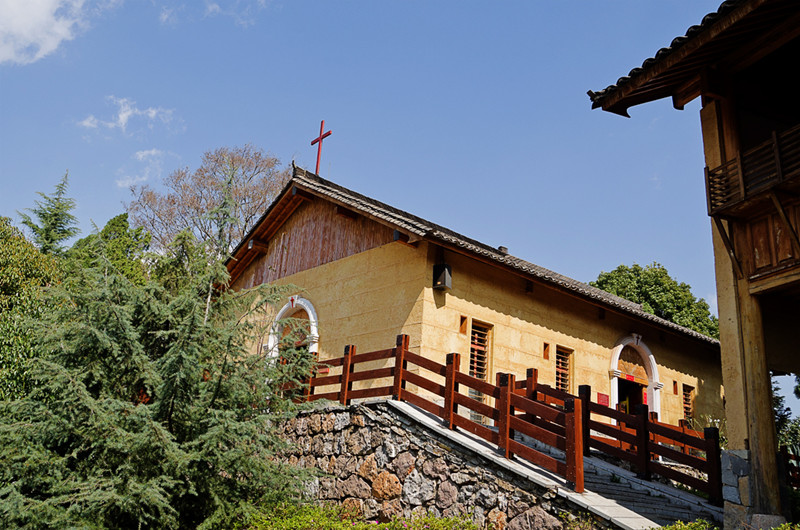
Location:
Overview
The Hani Village (哈尼寨) in Yunnan Ethnic Village covers 15 acres and showcases traditional Hani architecture and culture. Key features include:
- Mushroom Houses (蘑菇房): Typical residential structures with timber and earth construction, resembling mushrooms from a distance.
- Mother-Child Houses (爱尼母子房): Characterized by bamboo and wooden structures, where the main house is spacious, surrounded by smaller child houses.
- Sun and Moon Square (日月广场): A central area for gatherings and activities.
- Cultural Representations:
- A large relief sculpture illustrating the Hani legend of fish giving birth to all things.
- A totem pole depicting the migration legend of the Hani.
- Significant structures like the mill, Longba Gate (龙巴门), a swing area, and terraced fields (梯田).
- The ancestral tree (寨神树) and sacrificial stones (祭石) representing the Hani belief that “everything has a spirit” and their polytheistic worship.
Architecture
Hani architecture varies and can be categorized into four main styles:
- Eastern Tiled Houses (东瓦房)
- Earthen Houses (土掌)
- Southern Stilt Houses (南干栏)
- Thatched Houses (茅草房) in border areas
Mushroom Houses
- Structure: Typically multi-story, featuring stone foundations, earthen walls, and wooden columns.
- Roof Design: Built to withstand rain, facilitating food drying and preventing animal intrusion.
Mother-Child Houses
- Structure: The main house is spacious with an upper level for living and a lower level for livestock.
- Symbolism: Represents maternal affection and family unity, facilitating social interactions among youth.
Demographics
The Hani ethnic group (哈尼族) is a unique minority in Yunnan, with a population of approximately 1.65 million. Key points include:
- Geographic Distribution: Primarily found in the Three Rivers and Two Mountains region (三江两山地带), including the Honghe Hani and Yi Autonomous Prefecture (红河哈尼族彝族自治州). Other populations exist in Simao (思茅), Xishuangbanna (西双版纳), and Yuxi (玉溪).
- Cultural Relations: The Akha people (阿卡) in Laos and other regions are also related to the Hani.
- Language: The Hani have their own language but historically lacked a written script, with over 20 branches within the ethnic group.
Agricultural Practices
The Hani are renowned for their agricultural practices, particularly in rice cultivation:
- Historical Significance: They are considered one of the earliest ethnic groups to cultivate rice, abandoning traditional slash-and-burn methods for terraced farming.
- Terraced Fields: The Ailao Mountains (哀牢山) are home to numerous terraced fields, known for their dramatic beauty and agricultural innovation. The terraced fields in Yuanyang (元阳县) have become a cultural landscape.
Tea Cultivation
In addition to rice, the Hani are also among the first to cultivate tea:
- Oldest Cultivated Tea Tree: The “Shaguizhu” (沙桂茶), over 800 years old, grows in the Hani Mountain region in Banshan Village (半坡村) of Menghai County (勐海).
- Ecological Environment: The region’s ecological conditions are among the most suitable globally for tea cultivation, contributing to the Hani’s agricultural legacy.
Cultural Significance
The Hani Village in Yunnan Ethnic Village provides insight into the rich cultural heritage, architectural styles, agricultural practices, and historical significance of the Hani ethnic minority, highlighting their contributions to the region’s diversity and traditions.
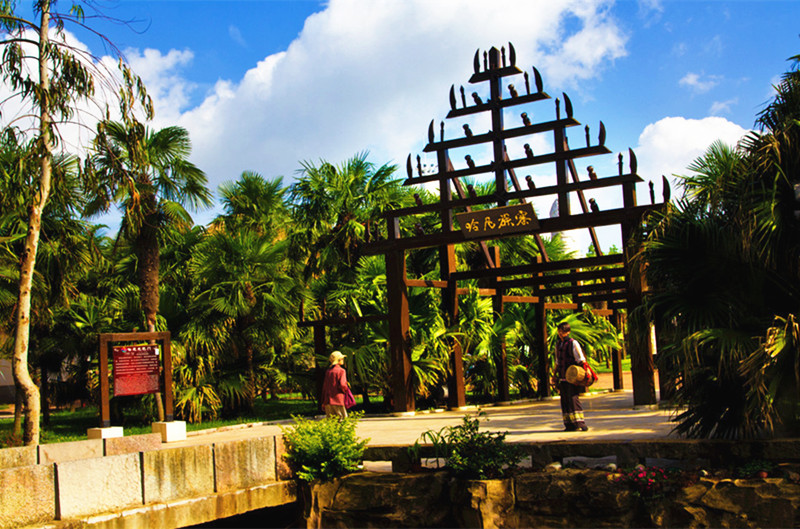
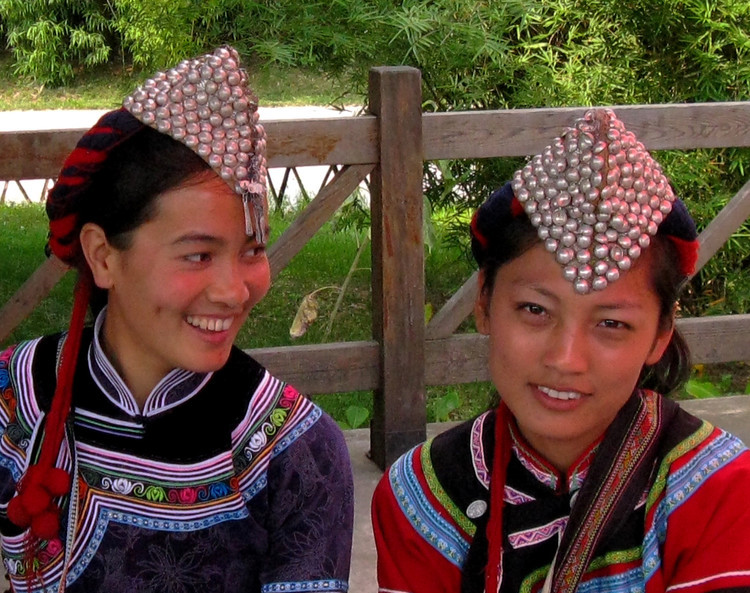
The Jingpo ethnic group, with a population of nearly 150,000, primarily resides in the Dehong Dai and Jingpo Autonomous Prefecture (德宏傣族景颇族自治州) in Yunnan Province (云南省). The Jingpo people practice an animistic religion, believing in the spirit of all things, worshipping deities, and venerating their ancestors.
Overview of Jingpo Village
The Jingpo Village (景颇寨) in the Yunnan Ethnic Village (云南民族村) covers an area of 15 acres and features spacious and elegant various types of residential buildings alongside the exquisite and splendid “Mountain Official’s House” (山官房). The architectural styles prominently showcase the Jingpo’s “stilt” (干栏式) and “inverted T-shaped” (倒T型) structural characteristics and layout forms. In the center of the square stands the “Muna Song Tower” (目脑纵歌示栋), with patterns and sculptures symbolizing the unity and determination of the Jingpo people.
Festivals and Traditions
The Jingpo people celebrate several traditional festivals, including the Muna Song Festival (目瑙纵歌节), the Nengxian Festival (能仙节), and the New Rice Festival (新米节). Among these, the most grand and significant is the “Muna Song Festival,” which is a traditional sacrificial event dedicated to the celestial deity Mudi. This festival typically takes place on the 15th day of the first lunar month. During the festival, people gather around the Muna Song Tower, engaging in group dances, which can attract tens of thousands of participants, creating a spectacular scene renowned for its “thousands singing and dancing.”
Attractions and Names Listed:
- Jingpo Ethnic Group (景颇族)
- Dehong Dai and Jingpo Autonomous Prefecture (德宏傣族景颇族自治州)
- Jingpo Village (景颇寨)
- Yunnan Ethnic Village (云南民族村)
- Mountain Official’s House (山官房)
- Muna Song Tower (目脑纵歌示栋)
- Muna Song Festival (目瑙纵歌节)
- Nengxian Festival (能仙节)
- New Rice Festival (新米节)
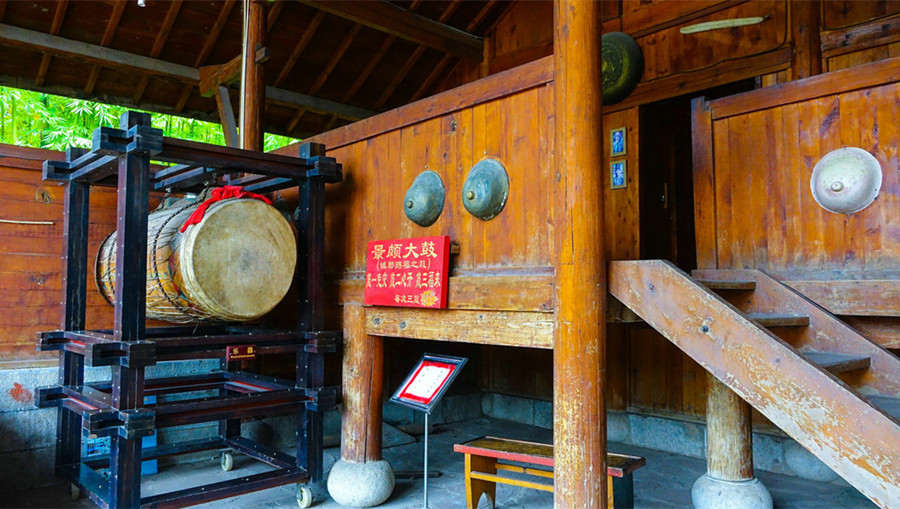
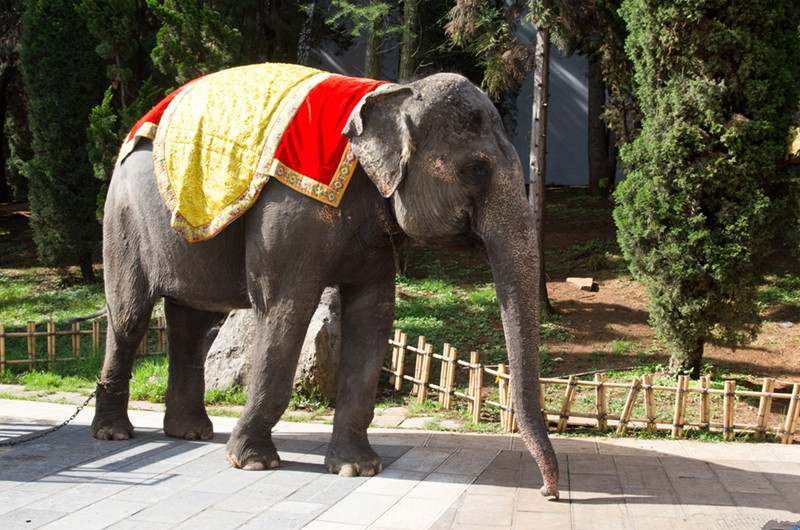
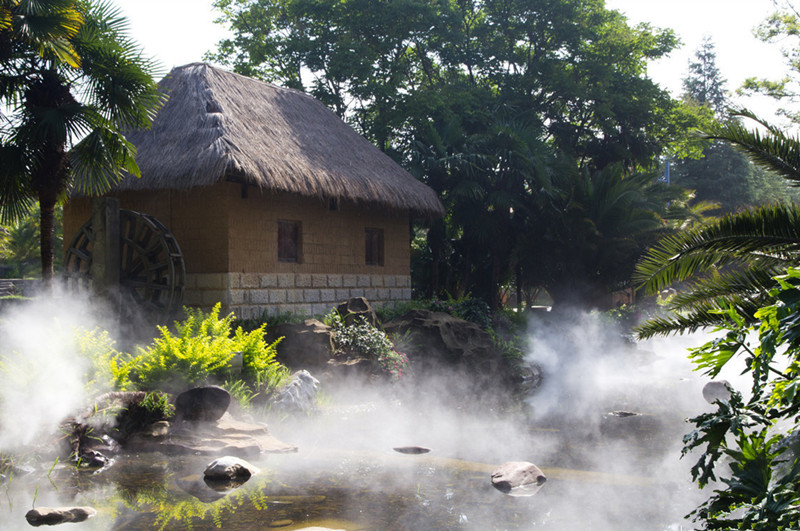
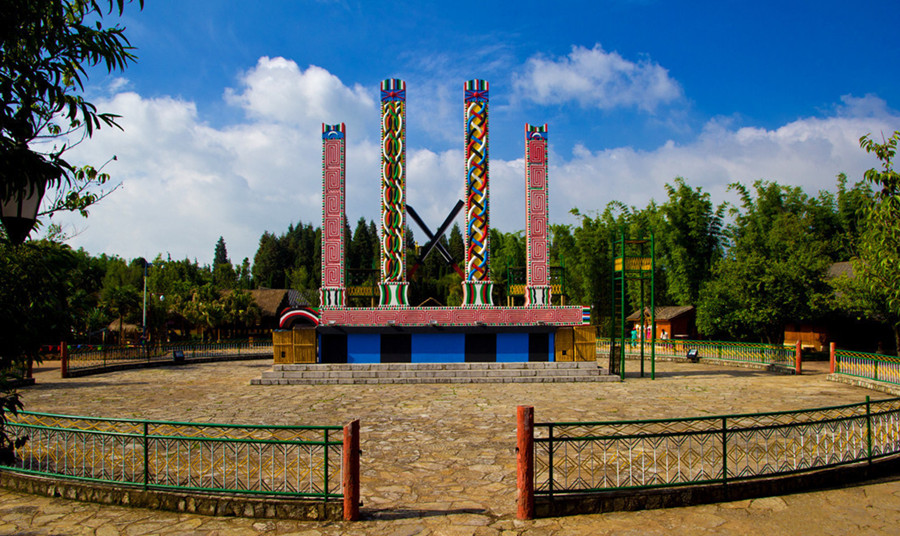
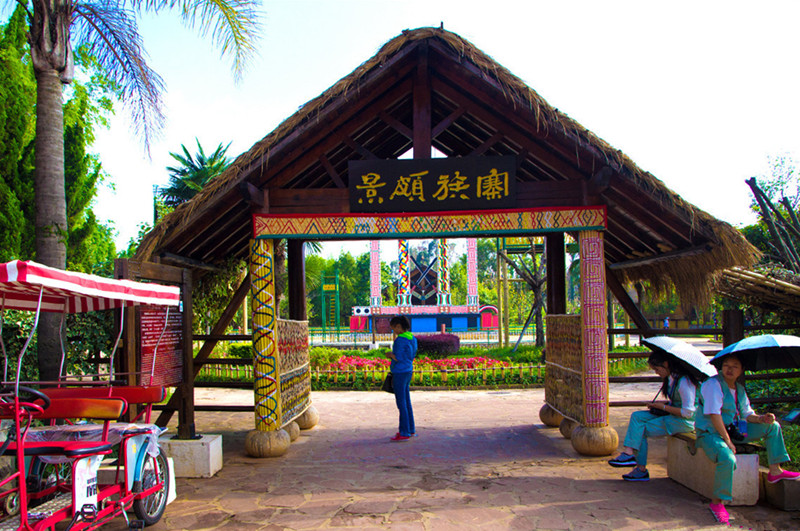
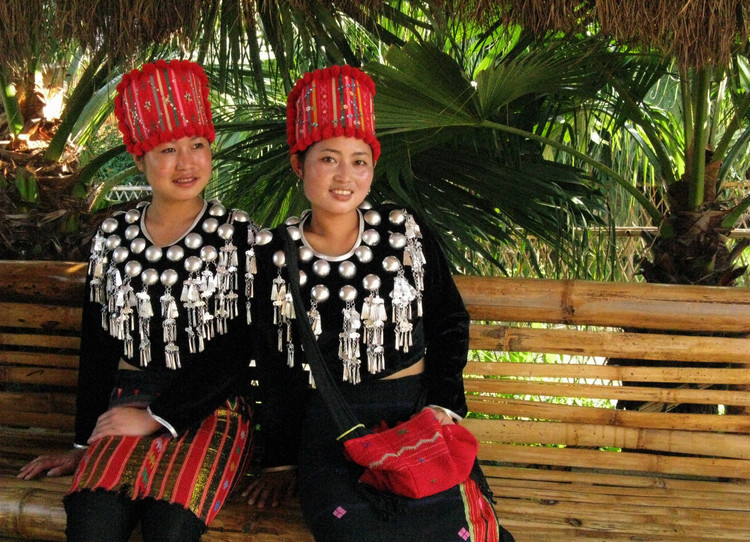
The Lahu ethnic group (拉祜族) has a population of nearly 480,000 and is an indigenous ethnic group unique to Yunnan Province (云南). They primarily reside in the vast region along the Lancang River (澜沧江) within Pu’er (普洱) and Lincang (临沧) cities. They self-identify as a “nation that emerged from a gourd” and deeply believe in an ancient religion that venerates the “omnipotence of natural forces.” In the 19th century, Christianity was introduced to the border areas, and the Lahu people incorporated it into their own culture, leading to a widespread tradition of guitar playing and singing that continues to this day.
Traditional Lahu Village and Cultural Elements
The Lahu village (拉祜族寨) in the Yunnan Ethnic Village is closely connected to the Jino village (基诺族寨). Within the village, one can find traditional Lahu thatched houses (拉祜茅草房), communal halls (大公房), cattle sheds (牛棚), as well as a gourd square (葫芦广场) and a totem pole array (图腾柱阵). The gourd square is centrally located and resembles a large flat gourd, featuring stone-carved gourds and ancestral stone slabs, which are prominent attractions. In the Lahu village, the swinging of swings, the melodious sound of gourd pipes, and continuous guitar performances showcase the vibrant “harvest dance,” filled with joy and passion, reflecting the Lahu people’s way of life.
The main traditional festivals of the Lahu people include the Spring Festival (春节) and the Gourd Festival (葫芦节). The Spring Festival is the most grandly celebrated event and is referred to in Lahu as “Kuanihani.” The Gourd Festival, a newer celebration called “A Peng A Long Ni” in Lahu, takes place from April 8 to 10.
The Lahu people are known for their singing and dancing, often incorporating production-related movements into their performances. Their dance styles include the Lusheng dance (芦笙舞), swing dance (摆舞), and song-dance (跳歌). The Lusheng dance is a large collective dance performed during festivals, with a total of 136 folk combinations recorded.
Living Environment and Traditional Clothing
As one of the 15 unique ethnic minorities in Yunnan, the Lahu people primarily inhabit the areas along the Lancang River in Pu’er and Lincang. The Lancang Lahu Autonomous County (澜沧拉祜族自治县) in Pu’er has the largest concentration of Lahu people. Legend has it that the Lahu people emerged from gourds, which they regard as a national totem, and their clothing is often adorned with gourd patterns.
Distinctive Traditional Clothing
The traditional clothing of the Lahu people is unique and varies according to lineage and residence. Men typically wear collarless, right-over-left, long shirts, and wide-legged trousers, often topped with a black turban or a melon-shaped cap.
Lahu women (拉祜西妇女) wear black cloth headscarves, collarless short jackets decorated with colorful geometric patches at the chest and cuffs, and long skirts. The clothing of Lahu Na women (拉祜纳妇女) retains characteristics from northern clothing styles since their migration southward, featuring a long headscarf adorned with colorful tassels, collarless short jackets, and high-slit long robes lined with neat silver beads at the neckline. Their tube skirts are decorated with elegant and beautiful patterns, giving them a dignified and luxurious appearance.
Architectural Characteristics of Lahu Villages
The Lahu people thrive in the subtropical region at an altitude of around 1,000 meters along the Lancang River. Nestled among lush, dense forests, their homes are arranged in a picturesque manner. The Lahu people live harmoniously with their natural surroundings, utilizing rich forest resources to create bamboo and thatch houses and elevated bamboo stilt houses (桩上双斜面竹楼房).
Their residences adhere to stilt house architecture, with slight variations between the two types. The simpler design reflects the essence of “building nests from wood.” The more elaborate bamboo stilt houses, which resemble those in nearby Dai villages (傣乡), come in two different styles based on the area they occupy. The larger, long-corridor-style stilt houses are known locally as “communal houses” (公房) or “long houses” (长屋), representing the transition from extended families to smaller family units and preserving aspects of the original matrilineal marriage organization and customs of the Lahu.
Cultural Heritage and Culinary Traditions
The Lahu village in the Yunnan Ethnic Village features thatched houses, communal halls, churches (教堂), cattle sheds, and the prominent gourd square. The gourd square, which resembles a large flat gourd and features a group of stone-carved gourds at its center, symbolizes the ancestral worship beliefs of the Lahu, who believe that their ancestors originated from gourds.
The Lahu are one of the ancient ethnic groups in China, known historically as “the tiger-hunting nation.” The name Lahu means “to eat tiger meat roasted over a fire,” reflecting their traditional practice of cooking hunted game on the spot, which fostered a cultural preference for roasted meat. Lahu roasted meat is uniquely flavored and typically cooked by sandwiching salted and spiced meat between two bamboo sticks and roasting it slowly over a fire until golden brown, fragrant, and crispy. Alternatively, the meat can be wrapped in banana leaves and buried in the fire until cooked. This roasted meat is crunchy and delicious, often served with spicy seasonings for an appetizing experience.
Secret Recipe: Grilled Chicken Wings
For those who love barbecue, this authentic ethnic dish is a must-try!
“In auspicious days, we come together, singing the songs from our hearts, nourished by a sweet and happy life. The Lahu people sing passionately…” Dressed in traditional clothing, Lahu youths gather, playing guitars and singing folk songs. This scene is common in Lahu villages, resulting from the intersection of ethnic and global cultures.
In the past, Christianity was introduced by British clergy to the border areas. The Lahu people showed great interest in the expressive capabilities of the guitar, adapting it to their culture and becoming a people who sing and play their local songs. These Western musical instruments gradually became integrated into Lahu life. Along the fields and by the campfires, Lahu people express their emotions through guitar music, singing to friends or serenading their lovers. The heartfelt lyrics and beautiful melodies flow in a rhythm filled with “Lahu flavor.”
Weaving as a Cultural Expression
Historically, Lahu ancestors living in dense forests had very few individuals skilled in weaving; they often exchanged hunted animals for clothing with other ethnic groups. After settling down, the Lahu began to learn spinning and weaving. This craft has been preserved for over 600 years, maintaining the traditional cultural characteristics of the ethnic group throughout history. Today, local villages still uphold the traditions of weaving, dyeing, and making their own clothing. Lahu women utilize a simple weaving method with a long bench and a beam to create beautiful visions of life with colorful cotton threads in shades of black, red, blue, and green.
The Lahu people’s aspirations for beauty manifest in their clothing and decorative items. In the Yunnan Ethnic Village Lahu village, young women inherit the craftsmanship of their ancestors, sharing the unique cultural charm of their ethnic group with the world.
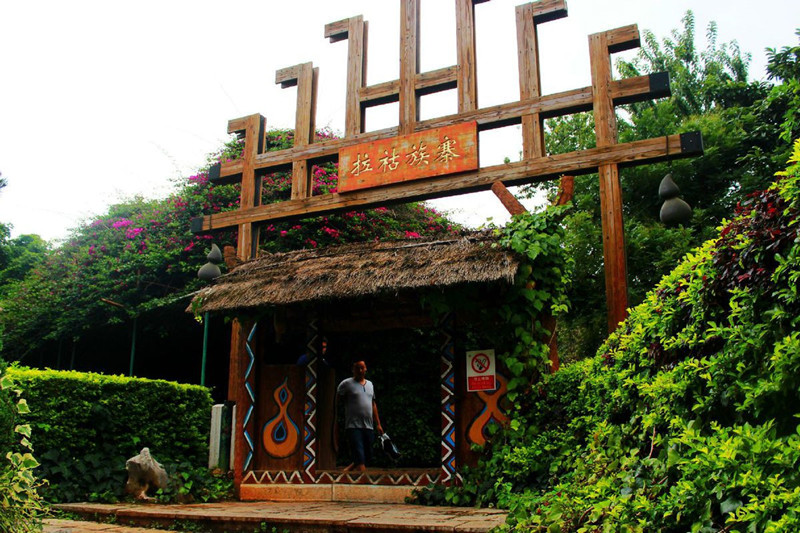
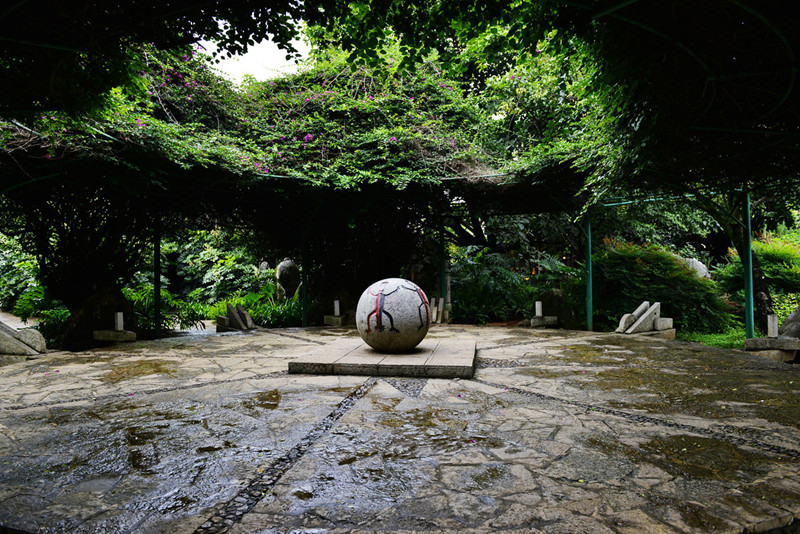
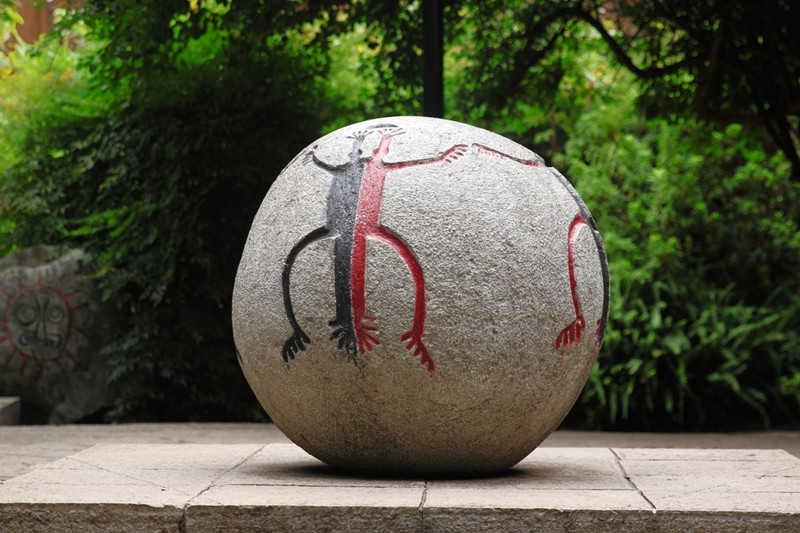
Overview
The Village of Jinuo Ethnic Minority is located in Yunnan Ethnic Villages, Kunming, at 1310 Dianchi Road, Xishan District, Kunming (云南省昆明市西山区滇池路1310号). It is a place that offers a deep insight into the culture of the Jinuo people (基诺族). The village showcases unique architectural styles, predominantly featuring stilted bamboo houses (“干栏式”竹楼) made of bamboo and thatch. This architectural style is commonly seen among ethnic minorities in Yunnan and is well-suited to the hot and humid climate of the region.
Visitors to the Jinuo village can experience traditional Jinuo lifestyles and cultural customs. The village offers numerous ethnic activities, such as the Jinuo Drum Dance (基诺大鼓舞) and Fire Dance (刀山火舞), which highlight the bravery and wisdom of the Jinuo people. Additionally, tourists can explore the communal longhouses, residential buildings, grain storage facilities, and the central Sun Square (太阳广场), where they can learn about the Jinuo way of life and customs.
Sun Square (太阳广场)
Sun Square is a significant area within the Jinuo village, reflecting the Jinuo people’s worship of the sun and their solar calendar. At the square, visitors can enjoy the lively and joyous “Sun Drum Dance” (太阳鼓舞), one of the most distinctive cultural activities of the Jinuo people. This dance not only celebrates the sun but also showcases the Jinuo’s strong connection to their natural environment.
Overall, the Village of Jinuo Ethnic Minority is an excellent destination for those looking to immerse themselves in Jinuo culture. Whether through its architectural style, daily life, or ethnic activities, visitors are sure to be captivated by the unique charm of the Jinuo people.
Introduction to the Jinuo Ethnic Group (基诺族介绍)
The Jinuo ethnic group has a population of approximately 23,000 people, making it one of the unique ethnic groups in Yunnan Province. They mainly reside in the mountainous areas of Jinuo in Jinghong County, Xishuangbanna Prefecture (西双版纳州景洪县的基诺山区). The Jinuo people are known for their musical and dance talents and possess a rich cultural heritage.
In Jinuo culture, there is a strong reverence for the sun. They worship the drum and decorate it with sun motifs, referring to it as the “Sun Drum” (太阳鼓). The Sun Square (太阳广场) is a sacred space where the powerful beats of the Sun Drum and the lively movements of the dancers express the Jinuo’s deep connection to the sun. The Sun Drum Dance (太阳鼓舞) is one of the most sacred and culturally significant activities for the Jinuo people, symbolizing their vibrant traditions and energetic spirit.
Jinuo Village Attractions
Jinuo Village is connected to other ethnic villages, such as the Lahu Village (拉祜族寨), and faces the Wa Village (佤族寨) and Bulang Village (布朗族寨) across the water. Upon entering the Jinuo Village, visitors will be greeted by striking rock formations surrounded by lush greenery and flowers. The thatched bamboo houses of the Jinuo people are scattered across the landscape, reminiscent of the rolling hills of the Jinuo Mountain region.
The village features various traditional structures, including the large communal house (大公房), residential buildings (民居楼), granaries (粮仓), and the Sun Square (太阳广场). Each of these attractions offers visitors a glimpse into the daily lives of the Jinuo people and their close relationship with nature.
Festivals and Traditions
The most significant and grandest traditional festival for the Jinuo people is “Temaoke” (特懋克). This festival, which marks the Jinuo New Year, translates to “Strike the Big Iron” (打大铁) and is a celebration of the creation and use of iron tools. In 1988, the People’s Congress of Xishuangbanna Prefecture officially designated February 6-8 of the Gregorian calendar as the “Temaoke” Festival (特懋克节) for the Jinuo people, based on their cultural traditions and customs.
The Jinuo Drum Dance
One of the most iconic and culturally important dances for the Jinuo people is the Jinuo Drum Dance (基诺大鼓舞). This dance has been recognized as part of China’s national intangible cultural heritage and Yunnan Province’s intangible cultural heritage. It is an expression of the Jinuo people’s connection to their ancestors, their reverence for the sun, and their vibrant cultural identity. The powerful drum beats and graceful movements of the dancers make the Jinuo Drum Dance a must-see for anyone visiting the village.
In conclusion, the Village of Jinuo Ethnic Minority in Yunnan Ethnic Villages is a culturally rich destination, offering visitors a unique opportunity to experience the vibrant traditions, customs, and lifestyle of the Jinuo people. From the stunning stilted bamboo houses to the lively Sun Drum Dance, every aspect of the village provides an unforgettable insight into the heritage of one of Yunnan’s most distinctive ethnic groups.
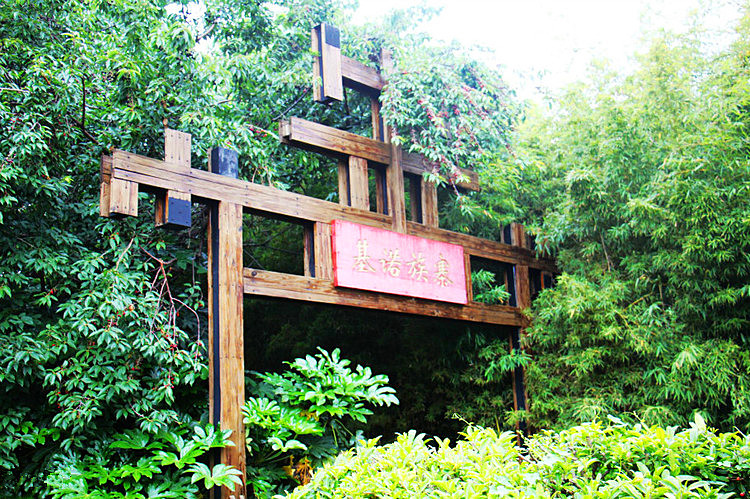
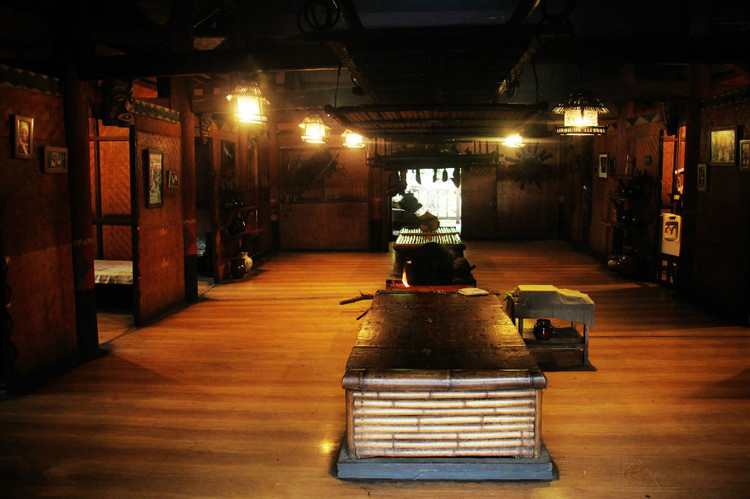
Location and Overview
The Village of Bulang Ethnic Minority is located within Yunnan Ethnic Villages in Xishan District, Kunming, on 1310 Dianchi Road (云南省昆明市西山区滇池路1310号). This scenic area is dedicated to showcasing the rich cultural heritage of the Bulang people (布朗族), one of Yunnan’s ethnic minorities. Surrounded by lush forests and abundant vegetation, the village offers a serene and picturesque environment, embodying the Bulang people’s deep connection to nature.
The Bulang ethnic group, with a long history and unique customs, speaks the Bulang language, which belongs to the Mon-Khmer branch of the Austroasiatic language family. While they have their own language, the Bulang people do not have a written script. The village features traditional architectural styles, such as stilt houses (干栏式民居), which are often two stories high. The lower floor is used for storage, while the upper floor serves as the living space, reflecting the ingenuity of the Bulang people in adapting to their environment.
Attractions within the Village
Ghost and Spirit Plaza (鬼神广场)
One of the key features of the Bulang village is the Ghost and Spirit Plaza, a sacred space where the Bulang people worship their deities and pray for happiness. In the center of the plaza stands the village’s totem, surrounded by stones engraved with images of the Bulang’s animal totems, the bamboo rat and toad (竹鼠和癞蛤蟆). These symbols reflect the Bulang belief in animism, the idea that all things in nature possess a spiritual essence. The plaza also serves as an important location for traditional performances, dances, and cultural activities, offering visitors a chance to experience the Bulang people’s vibrant customs.
Traditional Architecture
The village is home to several unique buildings, including stilt houses and community structures. These include:
- Traditional Stilt Houses (干栏式民居): These two-story homes are made of bamboo, with the lower floor used for storage and the upper floor for living, providing an authentic glimpse into the Bulang way of life.
- Totem Statues (图腾雕像): The village totem is prominently displayed in the plaza, representing the deep cultural and spiritual beliefs of the Bulang people.
Cultural Practices
The Bulang people have a rich oral tradition, and their culture is expressed through songs, dances, clothing, and customs. The village offers visitors opportunities to witness traditional Bulang performances, including:
- Traditional Songs and Dances: The Bulang people are known for their music and vibrant dances, which often take place in the Ghost and Spirit Plaza.
- Festivals: The Bulang celebrate numerous traditional festivals, such as their New Year, known as Sang Kan Bi Mai (桑衎比迈), which takes place in mid-June of the Dai calendar (around mid-April in the Gregorian calendar). The celebration lasts three days and includes activities like water splashing (泼水), sand piling (堆沙), and flower decorating (插花), depending on the region.
Cultural Insights
Bulang Language and Traditions
The Bulang people are a unique ethnic group primarily found in the western and southern parts of Yunnan, particularly in the mountainous areas along the lower reaches of the Lancang River (澜沧江). Their language belongs to the Mon-Khmer family, with two main dialects: Bulang and Ava (阿瓦). Despite not having a written script, the Bulang people have preserved their culture through oral traditions.
The Bulang people have a close relationship with the neighboring Wa people (佤族), with whom they have shared a long history of peaceful coexistence and mutual assistance. This relationship is reflected in the architecture of the Yunnan Ethnic Villages, where the Bulang and Wa villages are located adjacent to each other.
Animism and Religious Beliefs
Animism plays a central role in Bulang spirituality. They believe that spirits inhabit all aspects of nature, from animals to plants, and that unseen forces influence the well-being of their people. This belief is evident in their frequent ceremonies to honor spirits and seek their blessings for protection and prosperity. The bamboo rat and toad are among the most revered totems, symbolizing the connection between the natural and spiritual worlds.
Tea Culture
One of the Bulang people’s most cherished traditions is their tea culture. Bulang tea is renowned for its rich flavor, particularly their method of roasting tea leaves (烤茶). The leaves are placed in a special tea pot and roasted over an open flame. Once the tea releases a fragrant aroma, boiling water is added to brew a rich and aromatic drink. This roasted tea is considered the finest offering for guests and is a symbol of Bulang hospitality.
Festivals and Celebrations
Sang Kan Bi Mai (桑衎比迈) – Bulang New Year
The most significant festival for the Bulang people is their New Year, celebrated in mid-April. The festival is called Sang Kan Bi Mai, which translates to “New Year in June.” In Xishuangbanna (西双版纳), the Bulang New Year is celebrated with water-splashing festivities, similar to the Water-Splashing Festival (泼水节) of the Dai people. In other regions, such as Lincang (临沧), the festival is marked by building sand piles and decorating them with flowers, giving it the names “Sand Piling Festival” (堆沙节) or “Flower Decorating Festival” (插花节).
During the celebrations, Bulang families come together to perform ritual bathing ceremonies, clean family altars, and participate in community dances and feasts. The festivities are a time to honor their ancestors and celebrate the renewal of life.
The Village of Bulang Ethnic Minority in Yunnan Ethnic Villages offers visitors an immersive experience of the Bulang people’s rich history, unique architecture, spiritual beliefs, and vibrant cultural practices. From the peaceful Ghost and Spirit Plaza to the lively festival celebrations, the village provides a rare glimpse into the life of one of Yunnan’s most distinctive ethnic groups. Visitors can explore the traditions that have shaped the Bulang people’s identity for generations while enjoying the natural beauty and cultural heritage preserved in this picturesque village.
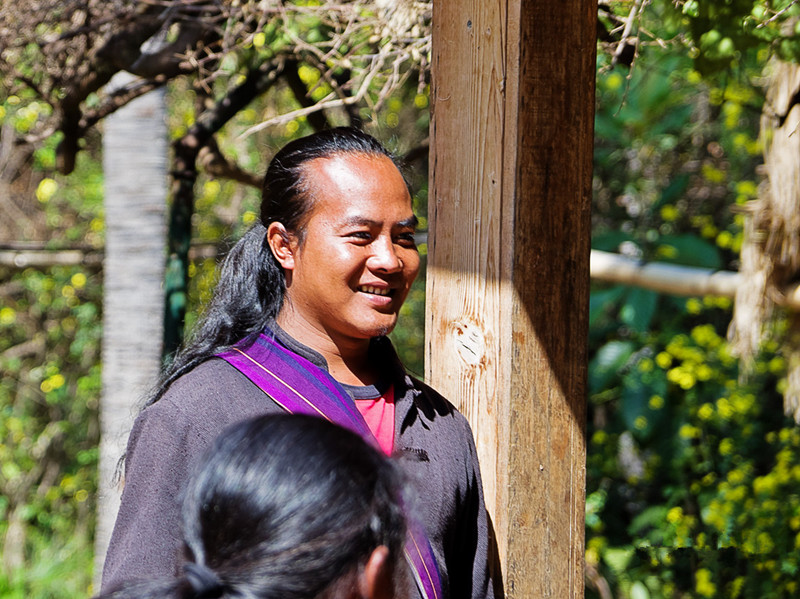
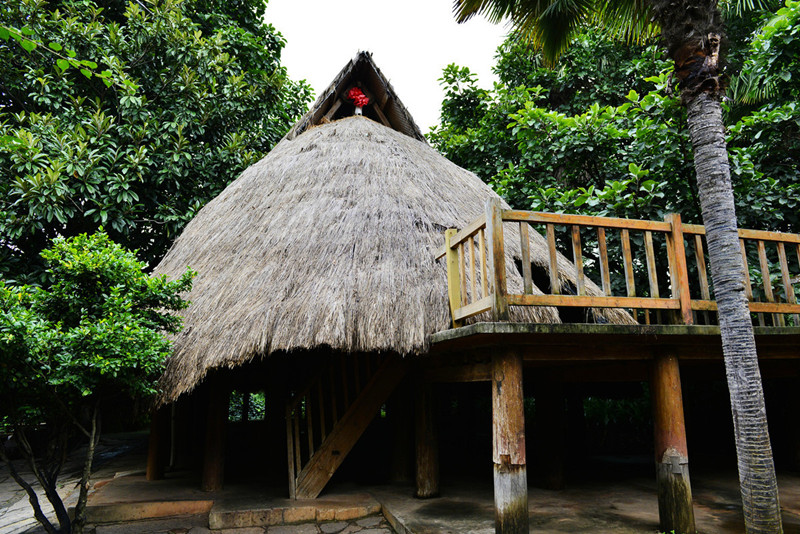
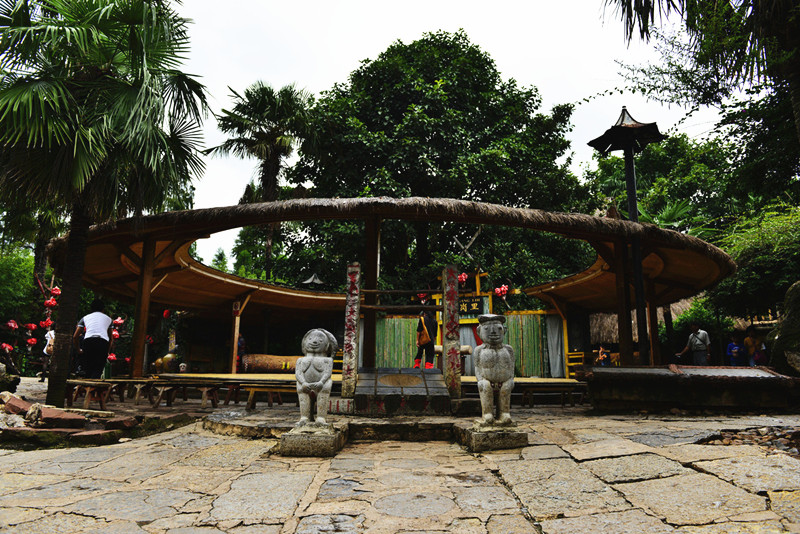
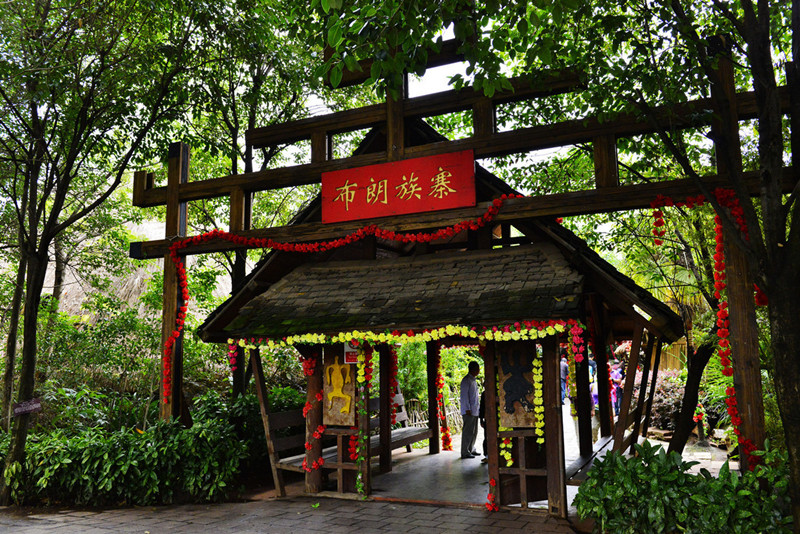
Overview
The Village of Yi Ethnic Minority in Yunnan Ethnic Villages (云南民族村–彝族村寨) covers over 50 acres. A significant feature is the “Three Tigers Relief Wall” and the “Tiger Mountain” sculptures, which highlight the Yi people’s cultural reverence for tigers. The central square, known as the Sun Calendar Square, features a totem pole adorned with symbols of the sun, tiger, fire, and the Eight Trigrams (八卦). Surrounding the square are ten moon-like sculptures, each representing different lunar phases, and the 12 Chinese zodiac animal statues.
The village is home to a complex of traditional Yi-style earthen houses called “Tuzhang Houses” (土掌房), built along the mountain, showcasing the harmonious relationship between the Yi people and nature. The village also includes a Tusi Courtyard (土司院), a cultural building, a Youth House (知青房), a winery, and an embroidery workshop.
Key attractions in the village include:
- Bullfighting Arena (斗牛场): A traditional sport of the Yi people.
- Tea Garden (茶山园): Visitors can relax in the tea garden.
- Cultural Celebrations: Yi festivals such as the Torch Festival (火把节), Yi New Year (彝族年), and others are celebrated with lively events like dancing, horse racing, and wrestling.
The Torch Festival (火把节) is the most famous festival of the Yi people. It typically takes place from the 24th to 26th day of the sixth lunar month. During the festival, people of all ages dress in traditional attire, make sacrifices to the spirits, and dance, sing, and celebrate through the night with torches, circling houses and fields before gathering around a bonfire to dance.
Historical Background of Yunnan Ethnic Villages
The Yunnan Ethnic Villages were established in 1992 and were one of the first scenic areas to receive a 4A national tourist attraction rating.
The Significance of the Tiger
The massive tiger head sculpture symbolizes the Yi people’s admiration and worship of tigers. Within the tiger head is a statue of the Yi shaman ancestor, Bimo (毕摩), holding an eagle-headed staff. Bimo is believed to be the creator of the Yi script. The word “Bimo” in Yi translates to “reciting scriptures” and “wise elder.” These shamans perform rituals, prayers, and sacrifices, and they also preserve and teach the Yi language, compiling and copying Yi texts.
Sun Calendar Square (太阳历广场)
The Yi solar calendar divides the year into five seasons, each with one male and one female month. Every month has 36 days, making a total of 10 months and 360 days. Additionally, there are 5-6 days for the New Year celebrations. The Yi solar calendar is recognized for its simplicity and is considered a cultural treasure in Chinese civilization.
In the center of the square, the totem pole is carved with images of the sun (太阳), tiger (虎), fire (火), and the Eight Trigrams (八卦). Surrounding it are sculptures of the 12 zodiac animals and ten moon sculptures representing the source of life.
Cultural Displays and Traditional Costumes
The village showcases the vibrant culture of the Yi people. Men are commonly referred to as “Ahei Ge” (阿黑哥), while women are called “Ashima” (阿诗玛). Visitors can also admire the exquisite traditional Yi clothing, known for its colorful patterns and vibrant designs.
The village adopts a method of restoring and displaying traditional Yi architecture, life, and customs, creating an immersive experience of the diverse ethnic cultures of Yunnan. The various ethnic minority villages are harmoniously arranged with unique styles and rich cultural expressions, making this area a microcosm of Yunnan’s ethnic culture.
Attractions in the Village
- Bullfighting Arena (斗牛场): A venue for traditional Yi bullfighting competitions.
- The Twelve Zodiac Animal Statues (十二生肖): Located around the Sun Calendar Square, these sculptures represent the 12 animals of the Chinese zodiac.
- Tuzhang Houses (土掌房): Traditional Yi-style homes constructed from earthen materials.
- The Tree Stump and Clover Discovery: Visitors often search for four-leaf clovers in the surrounding green spaces, considered a sign of good luck.
Yi Culture Highlights
The mysterious connection between the Yi people and the sun is displayed in the Sun Calendar Square (太阳历广场), while the red Tuzhang Houses (红色掌房) demonstrate the Yi’s ancient and optimistic civilization. The giant wine vats further reflect the Yi’s hospitable nature.
Three Tigers Relief Wall (三虎浮雕墙)
This artistic wall features the image of the Yi ancestor along with representations of tigers and eagles, illustrating the deep cultural symbolism of these animals in Yi mythology. The abstract tiger figures express the artistic and cultural uniqueness of the Yi.
Scenic Overview of Yunnan Ethnic Villages
Yunnan Ethnic Villages are a masterful combination of scenic beauty and cultural heritage. The landscape of the village features an intricate mix of water and land, with village houses nestled among shaded paths, pavilions, arch bridges, and stone steps, all connected to the lakeside avenue of Dianchi Lake (滇池). Visitors can explore winding routes through the scenic area, discovering new and captivating views at every turn.
Ecological and Animal Features
The water hyacinth (水葫芦), known for absorbing heavy metal ions, once posed an ecological threat but is now repurposed as animal feed.
Elephant Show Park (吉象园)
Covering 11 acres, the Elephant Show Park (吉象园) includes a performance area, elephant housing, and activity zones, making it one of the largest facilities in China for Asian elephant care and performances. Visitors can get up close to the elephants and watch fascinating shows.
The King of Thailand’s Coconut Trees (泰王贡椰)
Within the village, there are Thai royal coconut trees (泰王贡椰), symbolizing friendship and cultural exchange between Yunnan and Southeast Asian countries.
Conclusion
The Village of Yi Ethnic Minority in Yunnan Ethnic Villages offers an authentic, immersive experience of the Yi people’s culture, with its striking architecture, rich traditions, and deep reverence for nature. From the majestic totem pole in the Sun Calendar Square to the vibrant celebrations of the Torch Festival, visitors are invited to explore the diverse world of one of Yunnan’s most unique ethnic groups.
Chinese poetry and sayings inscribed in the village remain as a testament to the Yi people’s ancient wisdom and traditions:
- “日月天地,生生不息” (The sun and the moon, heaven and earth, life continues endlessly.)
Overview
Yunnan Ethnic Villages (云南民族村) is located on the southwest outskirts of Kunming (昆明), Yunnan Province (云南省), by the shores of Dianchi Lake (滇池). Covering an area of 89 hectares, it is a showcase of the social and cultural customs of 26 ethnic groups in Yunnan. It is a national AAAA-rated tourist attraction, a base for ethnic culture, and one of the first national points for ethnic work contacts. The Bai ethnic minority village (白族村) is the largest among all the ethnic villages in Yunnan Ethnic Villages (云南民族村).
The Bai ethnic group (白族) is one of Yunnan’s indigenous ethnicities, with a population of 1.93 million, primarily concentrated in Dali Bai Autonomous Prefecture (大理白族自治州). The Bai people (白族) have a long history and rich culture. Their folk arts, such as the “Bawang Whip” dance (霸王鞭舞), “Straw Hat Dance” (草帽舞), and “Daben Song” (大本曲), are filled with joy and celebration. Their traditional festivals include the lively “March Street” (三月街), “Around Three Spirits” (绕三灵), and “Welcoming the Bride” (迎新娘). The Bai’s traditional “Three-Course Tea” (三道茶) is a unique cultural tea ritual, representing one of the most distinctive tea cultures among Chinese minorities.
Architecture and Attractions
The Bai Ethnic Village (白族村) covers an area of 62.5 acres. It features traditional Bai-style residential buildings with upturned eaves, intricate carvings, and painted beams. Architectural highlights include the “San Fang Yi Zhao Bi” (三坊一照壁) (Three Rooms and One Wall), “Si He Wu Tian Jing” (四合五天井) (Four Houses with Five Courtyards), wooden carving houses, garden tea houses, opera stages, and the “Ben Zhu Temple” (本主庙). Additionally, there is a scaled-down version (one-fourth of the original size) of Dali’s famous “Three Pagodas of Chongsheng Temple” (崇圣寺三塔). The village’s layout is spacious, orderly, and elegant, with courtyards set one after another.
A major street called “Dali Street” (大理街) runs through the village, lined with shops selling exquisite handicrafts and traditional Bai snacks. Along this street, visitors can explore the Folklore Museum (民俗博物馆) and the Nanhua Village Silver and Copperware Store (南华村银铜器商店), offering local crafts.
Traditional Festivals
The “March Street” festival (三月街) is a grand and ancient Bai tradition, described as “one market every thousand years, one street that spans a millennium.” During this festival, markets are set up, drawing countless merchants. They trade in local products, traditional herbs, livestock, and daily necessities. Other major events include traditional horse racing, dragon boat racing, archery, swing competitions, and performances of “Daben Song” (大本曲) and “Dongjing Ancient Music” (洞经古乐), as well as ethnic song and dance performances. Other Bai festivals include the Torch Festival (火把节), Around Three Spirits (绕三灵), Shibao Mountain Song Festival (石宝山歌会), Jianchuan Mule Fair (剑川骡马会), and the Ben Zhu Festival (本主节).
Bai Architecture
Bai traditional residential architecture is highly regarded in the construction world. The Bai’s “San Fang Yi Zhao Bi” (三坊一照壁) (Three Rooms and One Wall) and “Si He Wu Tian Jing” (四合五天井) (Four Houses with Five Courtyards) are both practical and aesthetically pleasing. The white-walled, black-tiled courtyards feature wood carvings, painted designs, stone engravings, and plaster art that rival the gardens of southern China and the grand homes of the north.
Visitors can also see the “Three Pagodas of Chongsheng Temple” (崇圣寺三塔), which have been reduced to one-fourth their original size for the village display. The pagodas reflect the charm and historic architecture of the Dali (大理) region.
Cultural Experiences
The Bai (白族) are known for their hospitality. When receiving guests, the Bai people follow the custom of offering tea and alcohol. Their famous “Three-Course Tea” (三道茶) is a traditional way of honoring guests. Interestingly, the Bai people only fill a cup of tea halfway, as they believe that filling it to the top is disrespectful. In contrast, they fill alcohol cups to the brim, as full cups are a sign of respect. When you are treated warmly by the Bai, it is polite to say “Nuowei Ni” (诺为尼) (Thank you) to express your gratitude.
Respect for elders is a key virtue among the Bai people (白族). When encountering older people, one is expected to greet them, make way for them, offer seats, and serve them tea or cigarettes. The family’s hearth is considered sacred, and it is forbidden to spit into the fire or step over it.
Major Attractions in the Village
- San Fang Yi Zhao Bi (三坊一照壁) – A traditional Bai courtyard with three houses and one decorative wall.
- Si He Wu Tian Jing (四合五天井) – A layout with four houses and five courtyards.
- Ben Zhu Temple (本主庙) – A temple dedicated to the Bai people’s deity, Ben Zhu (本主).
- Dali Street (大理街) – A street offering local crafts and Bai snacks.
- Three Pagodas of Chongsheng Temple (崇圣寺三塔) – A one-fourth scale replica of the famous Dali pagodas.
- Garden Tea House (园林茶室) – A place to enjoy traditional Bai “Three-Course Tea” (三道茶).
- Opera Stage (戏台) – A traditional stage where local performances are held.
- Butterfly Garden (蝴蝶园) – A small garden filled with beautiful butterflies.
- Folklore Museum (民俗博物馆) – A museum showcasing Bai customs, crafts, and heritage.
Bai Culture and Art
The village’s art and craftsmanship are on full display, from intricately carved wood decorations to colorful paintings. Skilled local artisans can often be seen at work, applying gold leaf to wood carvings. Even the temples exude an artistic charm, filled with poetry, paintings, and carvings.
The Bai (白族) also take great pride in their folk arts, such as the “Bawang Whip” dance (霸王鞭舞) and “Straw Hat Dance” (草帽舞). These performances often feature during festival times and add a lively, joyous atmosphere to the village. Another unique art form is the “Daben Song” (大本曲), a Bai opera-like performance filled with historical tales and local stories.
Culinary Delights
The Bai (白族) people are famous for their local snacks, and the village offers visitors a chance to sample some of their best-known dishes. One must-try item is roasted milk fan (烤乳扇), a traditional Yunnan snack made from milk, and one of Yunnan’s “Eighteen Strange Things” (云南十八怪) – as locals say, “Milk sold in pieces” (牛奶做成片片卖).
Grilled Erkuai (烤饵块) is another popular snack, a type of chewy rice cake that is grilled and served with various toppings. In the village, visitors can also try Bai stir-fried cool powder (白族炒凉粉), roast bamboo sticky rice (竹筒饭) (a Dai ethnic dish 傣族菜), and the famous roasted milk fan (烤乳扇).
Handicrafts
Yunnan (云南) is well-known for its jade, even though jade is not native to the region. The saying goes, “Jade comes from Burma” (玉出缅甸), but Yunnan has become China’s largest hub for jade trading. Jade gambling (赌石) is a centuries-old industry here, with the saying “one cut makes you rich, one cut leaves you poor overnight” (一刀穷一刀富), reflecting the high risks and rewards of the jade trade.
Visitors can also explore Bai embroidery shops (白族刺绣店), tie-dye workshops (扎染作坊), and other artisan stalls that showcase the region’s rich handicraft traditions.
Cultural Sayings and Inscriptions
Throughout the village, you can find many poetic inscriptions and artistic displays, such as:
- Cang’er Yuxiu (苍洱毓秀) (The Elegance of Cangshan and Erhai) – An inscription on the wall of the village.
- Song of the Double Cranes (双鹤之歌) – A relief sculpture in the village.
- “Deze Canger” (德泽苍洱) (Virtue Nourishes Cangshan and Erhai) – A plaque in the main hall of the temple.
- “Cang’er Yuxiu” (苍洱毓秀) (Cangshan and Erhai Nurture Beauty) – A decorative text found throughout the village.
This traditional village provides a glimpse into the ancient and rich heritage of the Bai people (白族) and their unique contributions to Yunnan’s diverse cultural tapestry.
Introduction to the Dai Village
The Dai Village (傣族村寨) is the first village you encounter upon entering the Yunnan Ethnic Villages in Kunming. Covering an area of 27 mu (around 4.5 acres), the village is surrounded by water on three sides, nestled amidst lush greenery. The village features traditional Dai-style stilted bamboo houses, connected by winding red sandstone paths that lead to a solemn Burmese-style temple (缅寺). The village showcases notable architectural landmarks, including a grand white pagoda (白塔), an intricately designed wind-and-rain bridge (风雨桥), and other structures such as the rain pavilion (风雨亭), well pavilion (水井), and bell pavilion (钟亭), which embody the vibrant Dai culture.
History and Culture of the Dai People
The Dai people (傣族) are one of China’s oldest ethnic groups, with a rich history and culture. They mainly reside in Xishuangbanna Dai Autonomous Prefecture (西双版纳傣族自治州), Dehong Dai and Jingpo Autonomous Prefecture (德宏傣族景颇族自治州), and the river valleys of the Lancang River (澜沧江). With a population of approximately 1.2 million, the word “Dai” in the Dai language means “freedom,” reflecting the people’s love for freedom. The Dai people have their own script, which belongs to the Tai-Kadai language family under the Sino-Tibetan languages. The Dai are known for their musical talents, love for dancing, and deep connection to water, which plays an integral part in their daily lives.
Architectural Highlights
The village’s architecture revolves around key elements such as the white pagoda (白塔), residential buildings (民居楼), craft houses (工艺楼), cultural halls (风情楼), and dining halls (风味楼). Smaller decorative features such as the water pavilion (泼水亭), well pavilion (水井), bell pavilion (钟亭), and the wind-and-rain bridge (风雨桥) add charm to the village’s overall landscape. The surrounding tropical plants—palm trees, banana trees, coconut trees, and sisal—enhance the village’s beauty, creating a lush, vibrant atmosphere.
Dai-Style Stilted Bamboo Houses
The “Dai-style stilted bamboo houses” (干栏式傣家竹楼) are traditional homes that perfectly reflect the Dai people’s lifestyle. These two-story structures have the living quarters on the upper level and spaces below for livestock and storage. The design is well-suited to the tropical environment, providing protection from heat, allowing airflow, and offering resistance to pests. The simplicity and natural beauty of the bamboo houses make them distinctive. A typical house features a cool platform for relaxing, washing, and entertaining. Inside, the space is divided into two sections: the outer room serves as a guest room and family activity center, while the inner room is used as a shared sleeping area. Dai homes often display fishing baskets, hunting rifles, and spinning wheels as part of their interior decor.
Burmese-Style Temple (缅寺)
A unique feature of the Dai Village is the Burmese-style temple, known as the “Mian Temple” (缅寺). This temple complex includes several structures such as the Buddha Hall (佛殿), the Water Pavilion (泼水亭), and the monk’s platform (僧台). The Buddha Hall is where monks chant scriptures and the Dai people worship Buddha. In front of the temple is the Water Pavilion, home to a ten-meter-long brightly painted wooden dragon (彩龙), which is supported by a bamboo frame. During the annual Water Splashing Festival (泼水节), people use this dragon to pour water and bless each other, a ritual symbolizing purification and the wish for happiness and good fortune.
Buddhism in Dai Culture
The Dai people are devout followers of Theravada Buddhism (上座部佛教), also known as Hinayana or Pali Buddhism. It is one of the three major schools of Buddhism in China and is widely practiced in the southwestern regions of Yunnan, particularly in Xishuangbanna (西双版纳), Dehong (德宏), and Simao (思茅). Other ethnic groups like the Blang (布朗族), Achang (阿昌族), and De’ang (德昂族) also follow this religious tradition.
Dai Cultural Festivals
The most significant cultural activity in the Dai Village is the annual Dai New Year celebration known as the Water Splashing Festival (泼水节). This joyous and lively event is the highlight of the village’s cultural calendar.
Water Splashing Festival (泼水节)
The Water Splashing Festival, also called the “Bathing the Buddha Festival” (浴佛节), is the most important celebration for the Dai people. It is also a traditional festival for the Blang (布朗族), De’ang (德昂族), and Achang (阿昌族) ethnic groups, commonly observed in the southwest and southern parts of Yunnan. The festival originated in India and spread to China through Myanmar, Thailand, and Laos along with the spread of Buddhism. According to local legend, the water splashing tradition began when seven maidens washed away the blood of an evil demon they had defeated. The festival takes place around the Qingming Festival and lasts for one to five days.
On the morning of the festival, young men and women climb the hills to gather wildflowers and tree branches to create offerings, which they carry to the temple. There, they construct a sand pagoda and decorate it with bamboo poles wrapped in colored paper. After listening to the monks chant prayers, people splash each other with water as a blessing for good luck and a bountiful harvest. It is said that the more water someone receives, the more blessings they are given. Other activities during the festival include bag-tossing games, releasing sky lanterns (点孔明灯), launching rockets (放高升), and singing and dancing.
Visitors are welcome to experience the festivities firsthand in mid-April, along with other traditional Dai celebrations such as the Opening the Gate Festival (开门节) and Closing the Gate Festival (关门节).
Closing Thoughts
The Dai Village in the Yunnan Ethnic Villages is a vibrant and immersive experience for anyone interested in exploring the culture, architecture, and festivals of the Dai people. From the intricately designed bamboo houses to the joyous Water Splashing Festival, the village offers an authentic glimpse into the life and traditions of one of China’s most culturally rich ethnic groups. Visitors are sure to leave with a deeper appreciation for the history and customs of the Dai people.
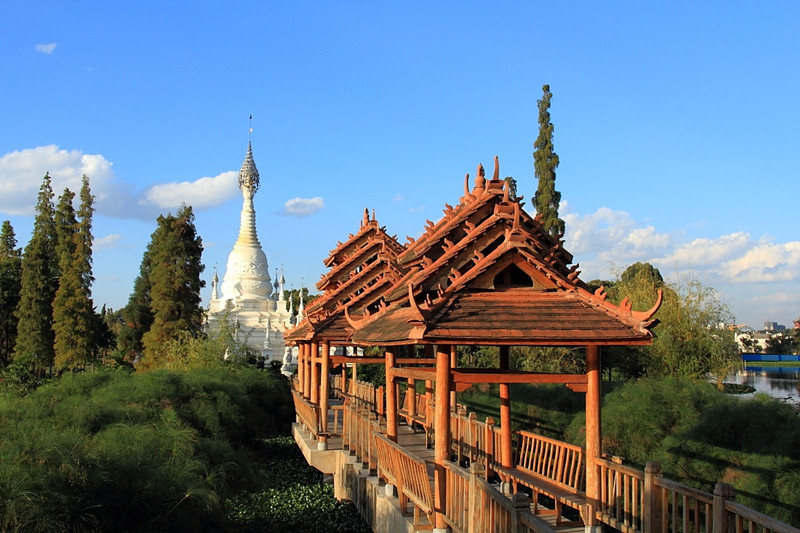
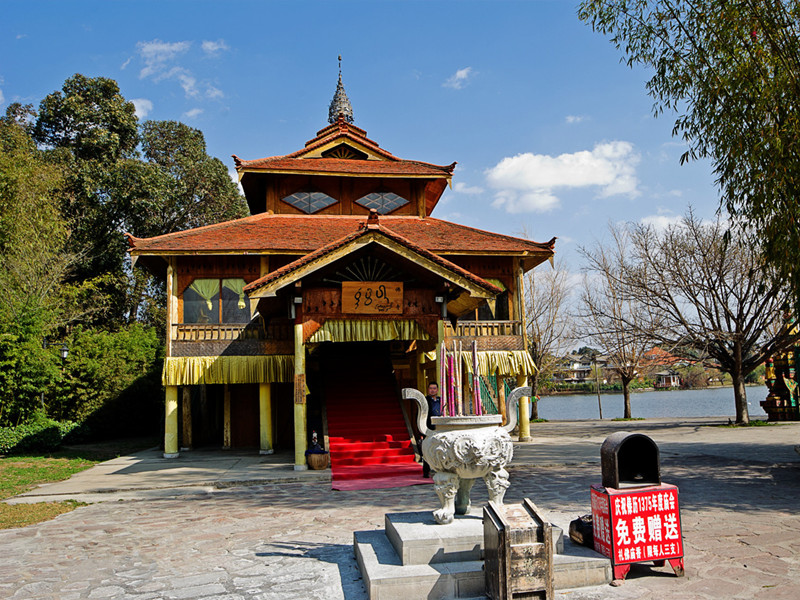
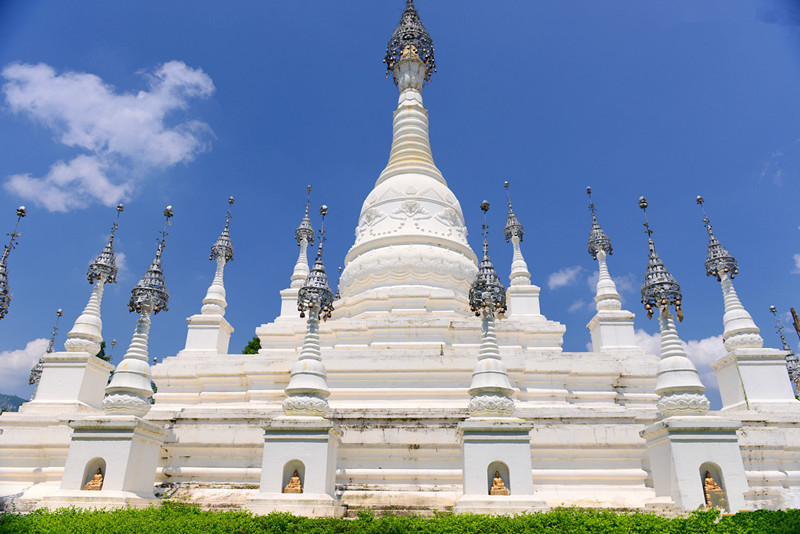
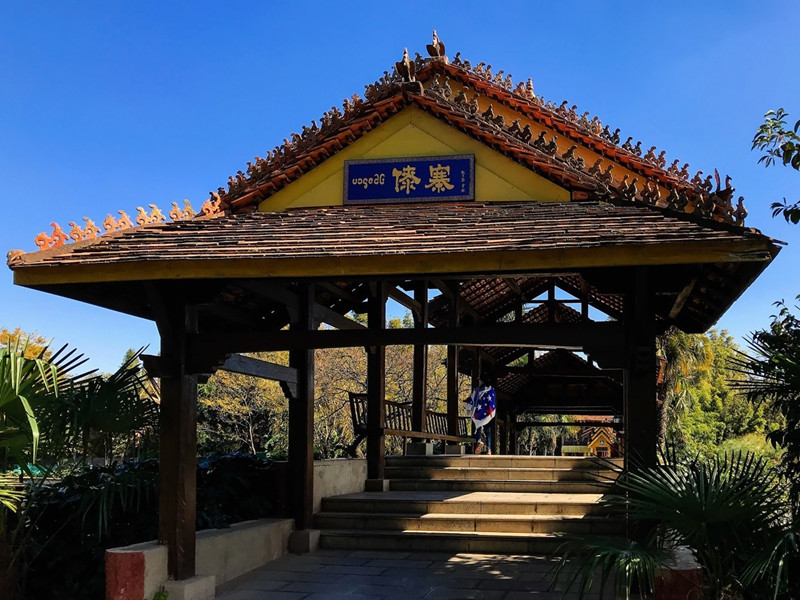
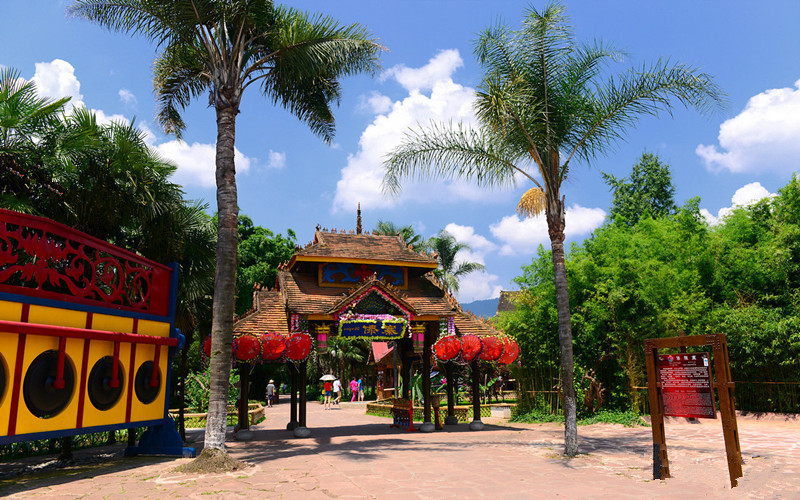
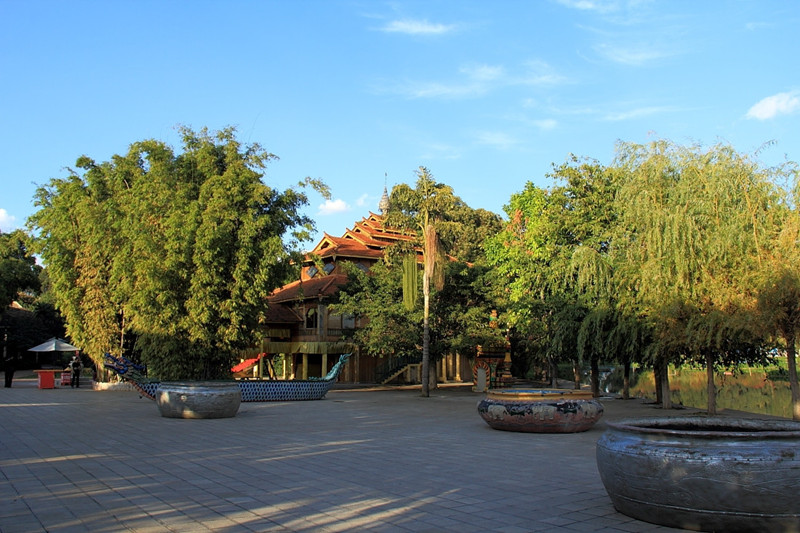
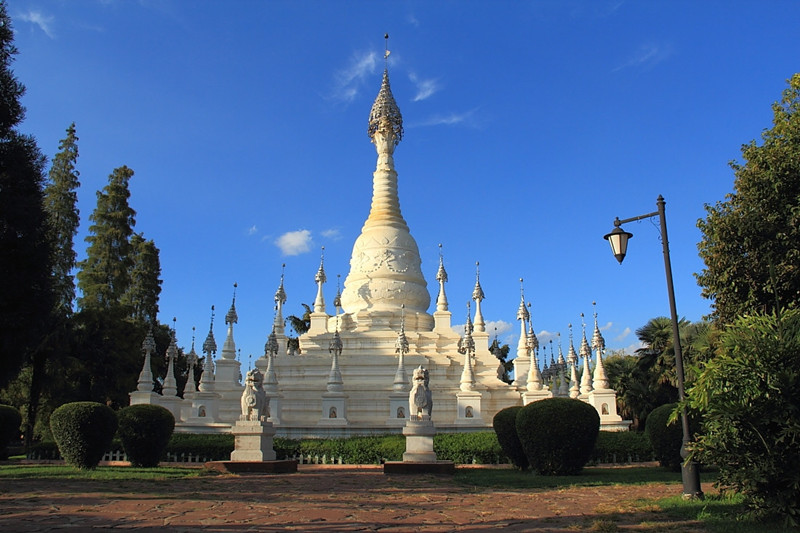
Introduction to Yunnan Ethnic Villages
Yunnan Ethnic Villages (云南民族村), located on the southwestern outskirts of Kunming City (昆明市), by the shores of Dianchi Lake (滇池), covers an area of 89 hectares. It serves as a window for showcasing the social and cultural customs of 26 ethnic groups in Yunnan Province (云南省). The village is a national AAAA-level tourist attraction, a national base for ethnic culture under the State Ethnic Affairs Commission, and one of the first contact points for ethnic work in China.
Since its opening in February 1992, Yunnan Ethnic Villages has vividly displayed the architectural art, traditional songs and dances, clothing, religious beliefs, and living customs of various ethnic groups in Yunnan. National intangible cultural heritage festivals, such as the Torch Festival (火把节), Water Splashing Festival (泼水节), and Munao Zongge Festival (目瑙纵歌节), are celebrated here. Over 30 national and provincial intangible cultural heritage items are exhibited, including the Wooden Drum Dance (木鼓舞), Guozhuang Dance (锅庄舞), and traditional folk songs like the Lisu Folk Song (傈僳族民歌) and Yi Folk Song “Haicai Tune” (彝族海菜腔). More than 10 traditional crafts, such as the Husa Knife-making Technique (户撒刀制作技艺), Jianchuan Woodcarving (剑川木雕技艺), and Yi Embroidery (彝族刺绣技艺), are also on display.
The Wa Ethnic Minority
The Wa people (佤族) are a unique ethnic group found mainly in Yunnan, with a population of 400,000. They are primarily concentrated west of the southern section of the Lancang River (澜沧江), in places like Cangyuan Wa Autonomous County (沧源佤族自治县) and Ximeng Wa Autonomous County (西盟佤族自治县). The Wa Wooden Drum Dance (佤族木鼓舞) is characterized by strong and vivid rhythms, and a wild, robust style. During the dance, Wa women swing their long hair gracefully, and their movements are bold and energetic. The annual rituals, such as bull sacrifices, rice pounding, and weaving traditional cloth, are full of life and deep cultural significance.
Wa Village in Yunnan Ethnic Villages云南民族村–佤族村寨
Wa Village (佤族寨) is located at the southeastern corner of “Cuiyi Island” (翠漪洲). The village features traditional stilted houses with thatched roofs, Bull Head Square (牛头广场), Spirit Square (神灵广场), Sigangli Stone Sculptures (司岗里石雕), and granaries. Bull Head Square is the traditional site for the ancient Wa bull sacrifice ceremonies. At the center of the square stands a bull horn, which represents the village’s central pillar. In front of the square are two stone statues, symbolizing the male and female ancestors of the Wa people. These statues are known as “Mu Yiji” (木依吉) and “A Yi’e” (阿依娥), the most revered figures in Wa mythology.
Spirit Square reflects the Wa people’s belief in animism, the idea that all things possess a spirit and that the soul never dies. The two stone figures in the square symbolize this belief and the Wa’s reverence for their ancestors.
Architectural and Cultural Highlights
The Wa village in Yunnan Ethnic Villages is designed with clusters of stilted houses featuring thatched roofs. The buildings are arranged around key cultural spaces such as Bull Head Square and Spirit Square. In Bull Head Square, the center is marked by a bull’s horn, representing the symbolic pillar of the village. The statues of “Mu Yiji” (木依吉) and “A Yi’e” (阿依娥) reflect the spiritual reverence the Wa people hold for their male and female ancestors, and the Spirit Square conveys their animistic belief system.
Traditional Festivals of the Wa People
- New Fire Festival (新火节): This is the Wa people’s celebration of the new year, symbolizing the farewell to the old and the welcoming of the new.
- Sowing Festival (播种节): Held around the 15th day of the third lunar month each year, this festival marks the beginning of the planting season.
- New Rice Festival (新米节): Celebrated in mid-August of the lunar calendar, this festival is dedicated to the first harvest of the year.
In addition to these, the Wa Wooden Drum Festival (木鼓节) was newly created in 2003 in Ximeng Wa Autonomous County (西盟佤族自治县), while the Sigangli Carnival (司岗里狂欢节) was introduced in 2004 in Cangyuan Wa Autonomous County (沧源佤族自治县).
Cultural Significance and Tourism
The Wa ethnic culture is vividly presented in Yunnan Ethnic Villages, allowing visitors to witness the life, customs, and history of this vibrant group. The cultural elements in the Wa village not only represent the past but are also a living display of their traditions. The traditional stilted houses, the lively festivals, and the striking wooden drum dance offer a deep dive into Wa culture.
For tourists, the Wa Village in Yunnan Ethnic Villages offers an immersive experience, where they can explore ancient customs, witness bull sacrifice ceremonies, and even participate in traditional Wa dances. The vibrant displays of art, architecture, and festivals make it a key highlight for understanding the diverse cultural landscape of Yunnan.
Key Attractions:
- Wa Village (佤族寨)
- Bull Head Square (牛头广场)
- Spirit Square (神灵广场)
- Sigangli Stone Sculptures (司岗里石雕)
- Wa Wooden Drum Dance (佤族木鼓舞)
- Mu Yiji and A Yi’e Statues (木依吉和阿依娥雕像)
- New Fire Festival (新火节)
- Sowing Festival (播种节)
- New Rice Festival (新米节)
- Wa Wooden Drum Festival (木鼓节)
- Sigangli Carnival (司岗里狂欢节)
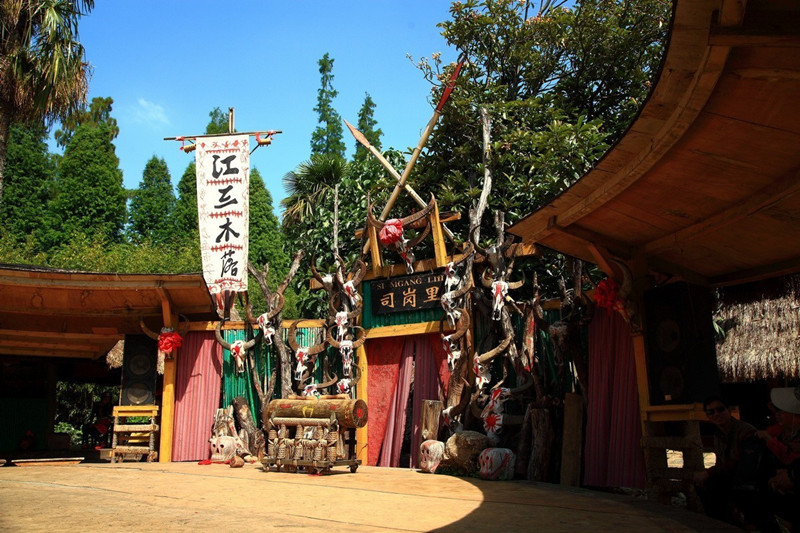
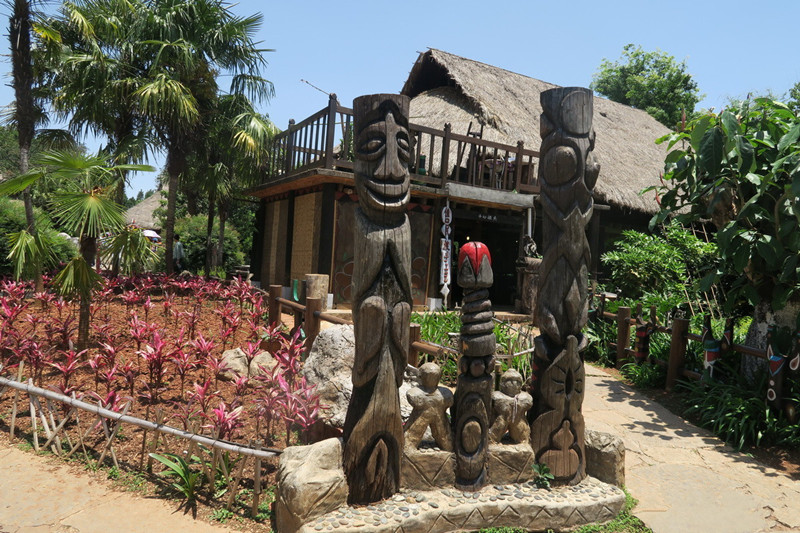
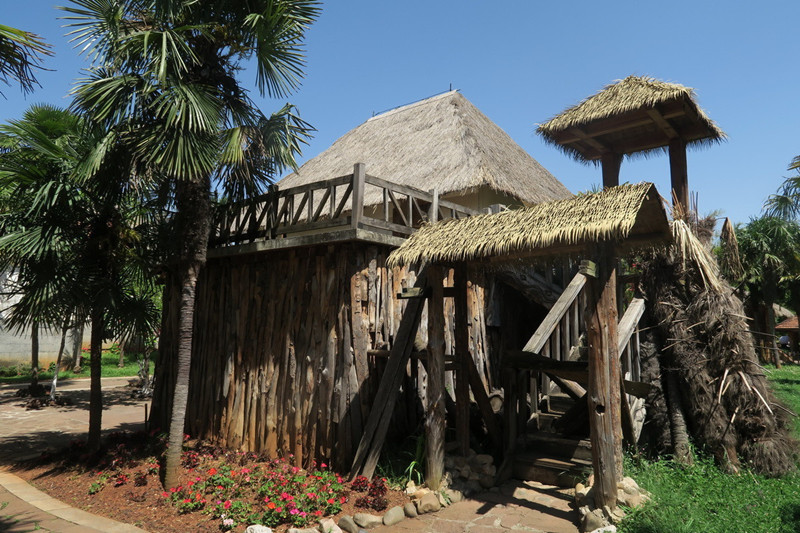
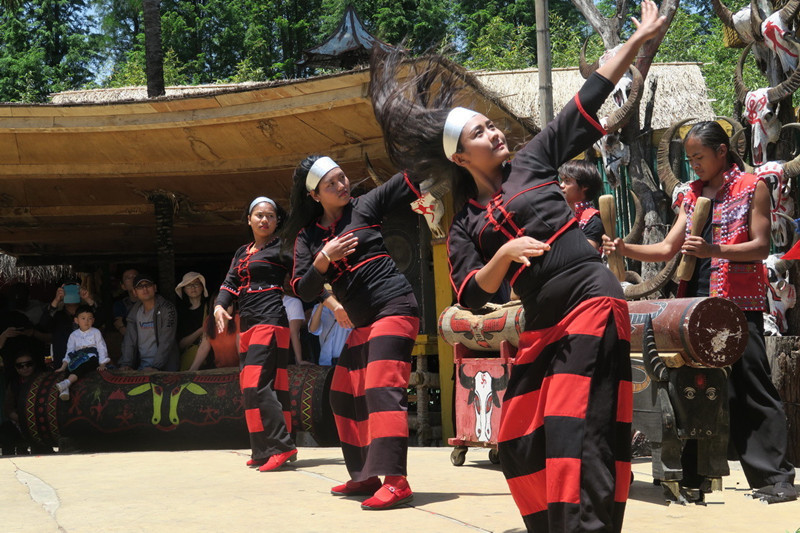
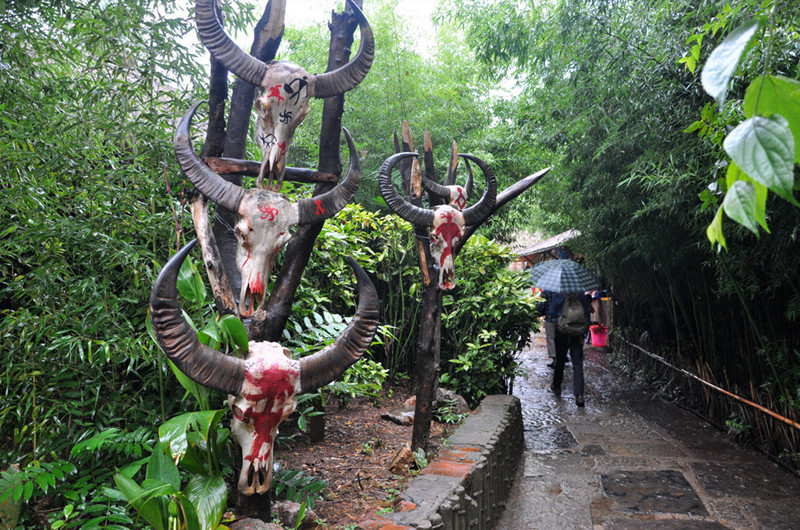

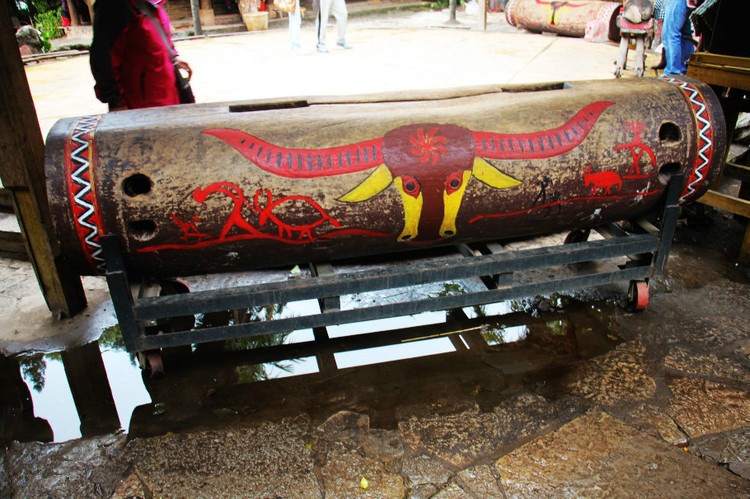
Village of Shui Ethnic Minority in Yunnan Ethnic Villages, Kunming
Introduction to the Shui Ethnic Minority (水族) The Shui ethnic minority (水族) in Yunnan (云南) comprises approximately 9,000 people, primarily engaged in agriculture. They reside mainly in the ancient...
Village of Zhuang Ethnic Minority in Yunnan Ethnic Villages, Kunming
Overview of the Zhuang Ethnic Minority The Zhuang (壮族) people predominantly reside in Wenshan Zhuang and Miao Autonomous Prefecture (文山州), with a population of approximately 1.22 million. Their villages...
Village of Miao Ethnic Minority in Yunnan Ethnic Villages, Kunming
Overview of the Miao Ethnic Minority The Miao (苗族) people primarily engage in mountainous agriculture and number approximately 1.2 million in Yunnan (云南), making them one of the largest...
Village of Hani Ethnic Minority in Yunnan Ethnic Villages, Kunming
Overview The Hani Village (哈尼寨) in Yunnan Ethnic Village covers 15 acres and showcases traditional Hani architecture and culture. Key features include: Mushroom Houses (蘑菇房): Typical residential structures with...
Village of Jingpo Ethnic Minority in Yunnan Ethnic Villages, Kunming
The Jingpo ethnic group, with a population of nearly 150,000, primarily resides in the Dehong Dai and Jingpo Autonomous Prefecture (德宏傣族景颇族自治州) in Yunnan Province (云南省). The Jingpo people practice...
Village of Lahu Ethnic Minority in Yunnan Ethnic Villages, Kunming
The Lahu ethnic group (拉祜族) has a population of nearly 480,000 and is an indigenous ethnic group unique to Yunnan Province (云南). They primarily reside in the vast region...
Village of Jinuo Ethnic Minority in Yunnan Ethnic Villages, Kunming
Overview The Village of Jinuo Ethnic Minority is located in Yunnan Ethnic Villages, Kunming, at 1310 Dianchi Road, Xishan District, Kunming (云南省昆明市西山区滇池路1310号). It is a place that offers a...
Village of Bulang Ethnic Minority in Yunnan Ethnic Villages, Kunming
Location and Overview The Village of Bulang Ethnic Minority is located within Yunnan Ethnic Villages in Xishan District, Kunming, on 1310 Dianchi Road (云南省昆明市西山区滇池路1310号). This scenic area is dedicated...
Village of Yi Ethnic Minority in Yunnan Ethnic Villages, Kunming
Overview The Village of Yi Ethnic Minority in Yunnan Ethnic Villages (云南民族村–彝族村寨) covers over 50 acres. A significant feature is the “Three Tigers Relief Wall” and the “Tiger Mountain”...
Village of Bai Ethnic Minority in Yunnan Ethnic Villages, Kunming
Overview Yunnan Ethnic Villages (云南民族村) is located on the southwest outskirts of Kunming (昆明), Yunnan Province (云南省), by the shores of Dianchi Lake (滇池). Covering an area of 89...
Village of Dai Ethnic Minority in Yunnan Ethnic Villages, Kunming
Introduction to the Dai Village The Dai Village (傣族村寨) is the first village you encounter upon entering the Yunnan Ethnic Villages in Kunming. Covering an area of 27 mu...
Village of Wa Ethnic Minority in Yunnan Ethnic Villages, Kunming
Introduction to Yunnan Ethnic Villages Yunnan Ethnic Villages (云南民族村), located on the southwestern outskirts of Kunming City (昆明市), by the shores of Dianchi Lake (滇池), covers an area of...
Tips Before Travel
Bring copies of your passport
Don't assume you're restricted to the main hubs of Beijing and Shanghai, our tours can start from any city.
Register with your embassy
For your safety, please register with the Embassy.
Always have local cash
Exchange some local currency for your trip
Our Team
Customize a Trip
Start planning your tailor-made holiday to China by contacting one of our specialists. Once enquired, you’ll get a response within 0.5~23.5 hours.
